PUBLIC SAFETY COMMITTEE MINUTES – JULY 9, 2014
BRIAN MAY, CHAIRMAN
MEMBERS PRESENT: Mr. Dougherty, Mr. Jordan, Mr. Holmquist, Mr. Ryan
ALSO PRESENT: See attached list
Chairman May called the meeting to order at 12:05 PM. A motion was made by Mr. Jordan, seconded by Mr. Dougherty to waive the reading and approve the minutes of the previous committee. Passed unanimously; MOTION CARRIED.
1. SHERIFF: James Rinella, Captain
a. Monthly Update on Status of:
1. Special Operations Facility
- Down to 3 locations
- Original draft received on Monday from VIP, revising at departments request, anticipate 2nd draft next week
Chairman May asked when the committee would receive this information. Captain Rinella responded that once they get it down to the locations they will have to talk to the Legislature, Mr. Millea and Mr. Owens. They are not at that point yet but he believes they are close, based on the yesterday’s conversation. They want to move this forward given the condition of the Special Enforcement Unit and the basement at the Joy Road property.
2. Pistol Permits
-
Lead agent Paul Silverstein from County IT; almost all data successfully imported - some hitches with software interaction, conducting weekly meetings with vendor
-
Hope to go live internally within 30 days – 3 step process
-
Work out bugs
-
Kiosk installed in lobby
-
Internet access - working with County Law to allow credit card use
Chairman May asked the timelines for the kiosk and internet. Captain Rinella responded that they want to have the kiosk installed by late summer or early fall, which was the goal.
Chairman May asked if the existence of the kiosk and internet would enable the County Clerk’s office to handle or assist with overflow. Captain Rinella responded that the kiosk will be in the lobby of the Sheriff’s office. A license fee will be associated with the software program for the internet piece, he doesn’t want to speak for Ms. Schepp. This is something that will have to be worked out with Chief Balloni’s successor or the new Sheriff and Ms. Schepp. It was his understanding that the Clerk’s office was going to try to work with to handle all the new applications going forward, get the backlog down and then be at a point where both offices could handle this. Chairman May requested that they keep this functionality high on their list of considerations, as it will be difficult to have personnel from the Clerk’s office in Pistol Permits going forward. Keeping those technical considerations at the forefront of the process will help from a cost and planning standpoint. Captain Rinella stated that as long as Ms. Schepp was willing to do this - doesn’t know what the licensing fees are. Chairman May stated that it was important to know these things because once the system is in place and the internet is available, “many hands make light work” and provide quick turnaround for pistol permits. Captain Rinella added that people are more computer savvy. If they were aware that it was on both the County Clerk’s and Sheriff’s website it would be perfect. This would mean a small education piece for the public, rather than the difficult challenge of coming downtown and trying to find a parking spot.
In answer to Mr. Dougherty, Captain Rinella stated the current wait time is approximately 3 – 4 months. Vacations are increasing the backlog slightly. Mr. Dougherty asked if the time was still dropping and if they expected it to be less in a few months. Captain Rinella responded, “No”. The County Clerk has been very gracious in giving them one of her personnel. However, after this week the additional person from the County Clerk’s office will no longer be available due to personnel challenges in the Clerk’s office. She has completed a great deal of work, had 79 appointments scheduled throughout August and was booked through October. They are going to have to find a way to address those appointments.
Mr. Holmquist asked if the timeline for the internet was the same as the kiosk. Captain Rinella responded they want to get the kiosk operating first. The internet would be the final phase, hopefully be year end, once the kiosk is working internally. There will be a learning curve for the public and they don’t want to “put the cart before the horse”.
Chairman May stated that the time is down to 3 or 4 months and asked if it was fair to say that the lion’s share of the time is now devoted to the investigation process and getting the permit through the court. Captain Rinella introduced Brian Crowley, who handles the permits. Deputy Crowley noted that the Captain mentioned there were 79 appointments however, that number was just for 1 book. They have 3 books filled with appointments. Amanda, from the Clerk’s office, was dedicated to new appointments. This does not take into account all the other books, and the people that come in from the street. The number 79 is probably about one-third of what they are dealing with for new applications. Above and beyond this are amendments to pistol permits, could be anything from a transfer in or out of county, or buying or selling a pistol. There is a very heavy workload and losing a person will have a large impact. They are severely understaffed. Captain Rinella added that he has had discussions with Chief Balloni and they are working on this. In addition, he has asked the Clerk if they could have Amanda for a day or day and half per week. They are adding a position to the 2015 budget, which will provide for a fulltime person to handle this function. Hopefully, they can “put this to bed” with the addition of the software and fulltime clerk. Chairman May noted that they are getting there. Mr. Holmquist stated that if they need 2 fulltime positions, they should do whatever is needed.
Mr. Holmquist asked if there was a different level of service speed via the kiosk, walking in off the street, or applying via the internet. Deputy Crowley responded not necessarily. The process has sped up over the last few years because of internet, e.g. Mental Health used to take a month, now it is back in a day. Much of the timeframe has to do with their internal backup. They had gotten appointments down from 18 months to 3 months, now it is starting to go the other way. They are getting more and more applicants and purchases because of the nature of things and the SAFE Act. The kiosk will help, but he doesn’t know what the impact will be until it is in place. Mr. Holmquist stated that there was no difference in terms of appointment dates. Deputy Crowley responded that his understanding was that with the kiosk the person would just complete the application. He does not know how this will be setup yet. Captain Rinella stated that it may be as simple as directing people to the kiosk when they come in. Chairman May stated this was different then coming in, standing around at the counter and then filling out the application or amendment. Deputy Crowley stated that he could focus more on amendments instead of working with walk-in applicants to complete their application, but imagines that there will still be some time spent with the applicant as the application must be signed by a certified police officer. Once the application gets to his desk they have already gotten through the window process, fingerprinting and so on. Deputy Crowley checks the references and background, then sends them onto the judges. Depending on the judge, if they are in trial, it could take up to a month. Everyone wants to know how long the process will take once he receives the application – it can take 2 weeks to 2 months.
Chairman May stated this was his point earlier, in bringing up the other components, they have gone past the technology issue and have automated the process to an extent that what remains is the human effort of background investigation and getting it to the judge. Deputy Crowley stated that this cannot be eliminated. Chairman May agreed adding that this is the essence of application. If they are able to fix this part, that is what they set out to do and the rest of it is a process that has to be undertaken. Mr. Holmquist stated that are many variables. Deputy Crowley agreed.
Mr. Ryan asked for the historical prospective over the past 5-7 years, noting that there has always been a waiting period and he believes there should be. He understands that there were some issues, the process was really backed up, but is now better. Captain Rinella responded that he doesn’t know the history, as he wasn’t in this position 5-7 years ago. As Deputy Crowley mentioned, this is very labor intensive and with the addition of the SAFE Act it has grown exponentially. People have concerns and they want to make sure that - Mr. Ryan interjected stating that his questioned had been answered, without being answered. This is a relatively new problem with the enactment of the SAFE Act. Prior to the SAFE Act the wait may have been a month or two.
Deputy Crowley stated that there was an increase in applicants leading up to the SAFE Act and it skyrocketed after the enactment. This was across the board, not just new applicants. In answer to Mr. Dougherty, Deputy Crowley confirmed that they are still receiving new applications at higher than usual numbers. Chairman May noted that this was hypersensitivity to the situation, there has been a steady climb for the past 6 years. Mr. Holmquist added that this started with the federal changes and when the state made changes it just exploded. Captain Rinella stated that this was a fair assessment. Chairman May stated that he applied for a permit 20 years ago and it took 3 or 4 months, which is their benchmark. Captain Rinella stated he knew a business owner who was transporting monies, applied a year ago and it took about 6 months.
Deputy Crowley suggested that legislators without a pistol permit call for an appointment and put themselves through the process so that they can see what people are currently going through. Something that should take a month or less, can take up to year; doesn’t think there is any excuse for this. Mr. Holmquist noted that this is how government treats its law abiding citizens. Deputy Crowley added that they are punishing law abiding citizens. Mr. Holmquist agreed.
b. 2014 Transfer Resolution-Sheriff Custody
- Requesting release of contingency funds - $436,722 to operate the Justice Center
Mr. Jordan stated that concerns were raised for items b and c with regards to the overtime portion of the request.
A motion was made by Mr. Jordan, seconded by Mr. Holmquist to sever and separately consider the overtime portions of items b & c.
Mr. Dougherty questioned Mr. Jordan’s concerns before voting. Mr. Jordan stated that the caucus had some concerns. There was sentiment raised that it would be better to consider the overtime items separately from the other requests, he is just the flag-bearer. Mr. Ryan stated that this is money that was budgeted. Chairman May responded that the contingency money was budgeted. Mr. Ryan stated that all of it was put into contingency, but part of the contingency was the line-item for overtime. This is all money that was appropriated for and just needs to be released.
Chairman May suggested that they discuss this for a minute and then deal with the motion.
Captain Rinella referred to the transfer summary sheet provided in the packet (Attachment No.1) and introduced Jennifer Fricano as their fiscal representative.
Captain Rinella:
- $1,250,000 placed into contingency for Police/Civil overtime, no release in 1st or 2nd qtr., requesting $825k for 3rd qtr., $425k remains/34%
- $1M in contingency for Custody overtime, no release in 1st or 2nd qtr. requesting $225k for 3rd qtr., $775k remains/78%
- Numbers may seem high but nothing was been released
Mr. Ryan stated that in a since they are catching up. Captain Rinella agreed. Mr. Ryan stated that if they are going to talk about this there should be a more in-depth conversation about why this much money needs to be transferred - being short staffed contributes to overtime and everyone gets upset about overtime. Legislators are here to be watchdogs of the county budget and fiscally responsible. However, there has to be realistic expectation that if we are continually reducing the number of deputies, this money will be made up on overtime. Captain Rinella stated that there are a few things:
-
Down from a high of 252 police deputies to 201
-
During the summer personnel are transferred out of the Sheriff’s office to IMPACT to help the City, also have navigation patrol was reduced by 50% to address overtime issues
-
Realities of a 24/7 365 emergency operation - things come up that they have no control of, e.g. 2 people missing – elderly man off Alan Road and 9 year old from Liverpool:
-
Very labor intensive, considered missing and endangered persons, used all available resources including K-9, aviation and volunteer search and rescue teams to mitigate overtime
-
Town and village agencies turnover major investigations to them because of lack of resources and personnel; towns and villages are county taxpayers
Mr. Ryan stated that village and town residents are paying for this service and the Sheriff’s department should be budgeting for it. Captain Rinella responded that there must be cooperation among the agencies in Law Enforcement.
Chairman May stated that since he has been on the legislature the Sheriff’s office has explained very well why they have overtime and budget for it. He believes that everyone present has a solid understanding and no one disputes it. Today’s issue is whether or not they should transfer the money out of contingency. For each budget item he would like them to talk about what is needed and what has been spent, as the amount spent is not listed on the spreadsheet. Aside from the overtime, the rest of the items are kind of obvious, e.g. automotive – maintenance expenses. There is no doubt those expenses will come up, but he would like to discuss them a little. The overtime piece is clearly the issue. They have budgeted money for this, but the funds are in contingency as a joint effort to manage those expenses. Commonly at year end they shore up this expense; not suggesting they do this now, they need to pay their bills on time. However, at the last committee meeting a report was given to provide an idea of where they think they will stand at year end. He wants to have a good understanding of the overtime and agrees with the idea of severing overtime from both resolutions.
Chairman May asked that they go over the accounts as listed and speak briefly about each, with the overtime to be discussed separately for each group. Captain Rinella:
- Automotive expense for vehicle purchases
- Supplies Police/Civil - firearms, ammunition, uniforms, copy paper, forms, basic office supplies and vehicle equipment
Chairman May stated he was asking if they have spent the money they had and if they need more money to - Captain Rinella interjected saying that they had not spent the money for the vehicles as they haven’t been released, the funds as sitting there.
Captain Rinella stated that bills come in and asked Ms. Fricano to respond:
- Kind of a month late, will be a month into 3rd qtr. when funds are released
- Number of the parent accounts starting to run out of money
Chairman May stated that this is what he was trying to determine. Ms. Fricano continued:
- Overtime Police/Civil - now in the red
- Supply line for both is starting to run on fumes – end of May had a month and a half left instead of 2 full months, trying to make do
Mr. Jordan stated that the summary provided list the amount short and asked if this was showing the deficiency in the accounts as of today’s date. Ms. Fricano responded that the report doesn’t show what has been spent.
Mr. Jordan stated the report states “Amount (Short)/Over After Available Funds not in Contingency” and assumed this to be the amount short in each account. Ms. Fricano responded that this was the amount associated prior to the 1st quarter. It is her understanding that when the year started they needed a larger amount of money for contracts and maintenance agreements and the numbers listed in that column are associated with that. What is being discussed now, are the things that she added to the sheet for the 3rd quarter. Mr. Jordan stated that these are actually positive balances for those accounts that could be transferred over. There were disproportionate shares of money for various accounts at the beginning of the year because of contracts. Ms. Fricano interjected saying, “and were spent”. Mr. Jordan added that they are ahead of the game for those accounts. Ms. Fricano responded that the answer would be yes if everything was relative to this quarter, but there are seasonality’s so they are not really ahead of the game. They have a lot of expenses that have to be paid for the entire year.
Mr. Jordan noted that they had $450,000 in the overtime operating budget for Police/Civil and $2.1 million for Custody and questioned what had already been allocated for overtime. Ms. Fricano stated that the overtime report provided last month was a projection. Since then they have tweaked the numbers a little and it looks like Police/Civil will be on point with the budget, but they have started to fall into the red because they are entering the 3rd quarter. Custody was projected to be over by $500,000 and this has increase slightly. They will have to wait for the next payroll to see where they will be. They haven’t fallen into the red for this account because they had more funds to start with.
Mr. Dougherty questioned how overtime was paid for thus far, as no money came out of contingency. Captain Rinella responded that they used funds in the operating budget. Ms. Fricano added that they had money in the account, not all of funds were put into contingency. Mr. Dougherty asked if they were now looking to replenish the account. Ms. Fricano stated that the available budget was for $2.1 million and $1 million was put into contingency; full budget $3.1 million. They stated with $2.1 million and now need to true up the account, this is why they are asking for $225,000. Mr. Dougherty noted that this was money they planned on spending from the very beginning, with the exception of $500,000 over on the one overtime line. Ms. Fricano added that the release will true them up to 75% of the $2.1 million total.
Chairman May stated he wants to know and see a whole lot more about the overtime situation. Each year the overtime account goes over budget and they bill the bill. This is a cash flow issue, not an accounting issue - it is not as if people aren’t going to get paid. This goes back to a month ago when they discussed car – it was not whether or why they should do certain things, but how. He would like to sever the overtime and dig into it a little further. Again, not why they need overtime, but how they are going to pay everything they need to pay.
Captain Rinella stated that he wanted to be clear, and questioned if they were going to vote on the overtime. Chairman May stated that they would vote on overtime as a separate resolution. If it doesn’t pass, his recommendation would be to have a plan to discuss it in more detail at the next Public Safety meeting. Captain Rinella stated that he doesn’t understand, there is recognition that emergency services have overtime. Chairman May reiterated that the issue isn’t why. Captain Rinella responded that essentially the Chairman is questioning how they are going to pay for it. Chairman May added not for this, but everything they are dealing with.
Chairman May stated that they were back to the same discussion they had at the last meeting and noted his disappointment in the fact that they did not have a car request on the agenda for the cars that are truly unsafe. He thought that something should have been done. Captain Rinella said to clear the record, he had a conversation with the Chairman of Ways and Means, sent him an email stating what was going to be on the agenda, came to Ways and Means and found the cars removed. Chairman May responded that they were still asking for the full request at Ways and Means, instead of asking for at least the 8 cars that needed to be replaced. Captain Rinella stated that they have a lot more than 8 cars that need to be replaced. Chairman May stated he understood this, but 8 or 9 cars fit into a category that he would like see them do something with. Captain Rinella said that those cars were a sample of a much larger problem, he knows that the Chairman understands, but this is much more than 8 or 9 cars and $489,000 is not going to address the critical problem. Chairman May reiterated that this is understood, but there was a specific issue that he hoped they would have addressed at this time.
Captain Rinella asked that someone find out why it was removed from the Ways & Means agenda; the resolution wasn’t voted on in Public Safety, was sent to Ways & Means, and unbeknownst to them was removed. Pamphlets were handed out with very visible critical problems, gas and brake lines were exposed. In his conversations with the Chairman, he was 100% ok with the item being on the agenda, then it was removed and he doesn’t know why. People are still driving those vehicles and it is a critical safety issue. If that money doesn’t get released, it is putting their people and the citizens of this county in danger. Chairman May stated that he made a specific suggestion with regard to all of that. There are things the Sheriff’s office knew they had to do and this was not done, which is undeniable as it didn’t happen. He thought they would at least handle the real serious issues, which are inevitable. Then the systemic problem with cars needs to be addressed together.
Chairman May stated that he did not want to drift. His point was that they have and are going to pay for these things, but they need to get a better handle on how they are going to do this. They want to understand the overtime component with respect to everything else that has to be spent and how the year is going to go.
Mr. Dougherty asked what additional information they were looking for, just to be clear. Captain Rinella added that he honestly doesn’t know what more they could be looking for. Chairman May stated that there isn’t even a number on the sheet to show how much has been spent this year. Mr. Dougherty responded that he didn’t want to debate this. Chairman May stated this was a good place to start.
Mr. Jordan asked what they were specifically asking for. Chairman May said he wants to know what has been expended to date, what they forecast to expend within the quarter of the request, and for the year. He then asked if anyone else had other ideas, adding that those two things would give him an awful lot of fundamental foresight into the situation.
Mr. Dougherty asked if these questions could be answered now by the people that track finances. Chairman May responded that he wasn’t sure he wanted to vote on an instant answer because there are more things to consider with respect to the dollars.
Mr. Holmquist said that perhaps at the request of this committee the 8 cars and the overtime, with the answer to those questions could be added to the Ways and Means agenda. Chairman May responded that he was not going to make the request, but Mr. Holmquist was welcome to do so. Mr. Holmquist said that he would ask Mr. Knapp to consider these items. If the overtime doesn’t pass, it has been considered and can be referred to the Ways & Means committee, and presumably they could get answers by Friday.
Chairman May stated they had a motion to sever the overtime for item b. Mr. Ryan asked if they were planning on voting on the overtime. Chairman May responded that he would like to vote on it as a separate resolution.
AYES: 3 (Holmquist, Jordan, May); NOES: 2 (Ryan, Dougherty); MOTION CARRIED.
A motion was made by Mr. Holmquist, seconded by Mr. Jordan to approve all items for b, except overtime. Passed unanimously; MOTION CARRIED.
c. 2014 Transfer Resolution-Police/Civil
Chairman May asked for a vote on the motion to sever overtime from item c.
AYES: 3 (Holmquist, Jordan, May); NOES: 2 (Ryan, Dougherty); MOTION CARRIED.
A motion was made by Mr. Holmquist, seconded by Mr. Jordan to approve all items for c, except overtime. Passed unanimously; MOTION CARRIED.
Chairman May asked for a motion on the overtime for item 1b. Mr. Jordan stated he would like to have the information in terms of where they stand. Mr. Holmquist asked if he was looking for a motion to approve the overtime. Chairman May responded that he was looking for a motion to take a vote, without a motion there will be no vote.
A motion was made by Mr. Ryan, seconded by Mr. Dougherty to approve the overtime for item b. AYES: 2 (Ryan, Dougherty); NOES: 2 (Holmquist, May); ABSTAINED: 1 (Jordan); MOTION FAILED.
A motion was made by Mr. Dougherty, seconded by Mr. Ryan to approve the overtime for item c. AYES: 2 (Ryan, Dougherty); NOES: 2 (Holmquist, May); ABSTAINED: 1 (Jordan); MOTION FAILED.
Chairman May asked if there was any other business. Mr. Ryan stated there has been some conversation lately about the possibility of civil deputies obtaining police officer status and going to a Police Academy. He doesn’t have a lot of details but thought this would be worthy of discussion. If there is a plan and this were to happen there would be some cause and effect, e.g. who would be doing this work, overtime, and contractual issues. There are a many questions that would need to be answered. He doesn’t know if Personnel and/or the department are involved. As law makers and decisions makers for the budget, this is something they need to be cognizant of.
Chairman May stated he had two comments:
-
Very recently he received superficial knowledge about the possibility of this happening, was 2nd and 3rd hand knowledge and there is a lot to know
-
Doesn’t know if it is within their purview to govern this matter, could certainly take a position; he is in a speculative position on this matter and heard that Personnel would send someone here
Mr. Ryan stated that other counties have gone to this, but by in large many of the civil divisions are considered peace officers, much like the police officer’s at Syracuse University. He is aware that there are some safety issues and they should be mindful that a number of their employees are out working without even police officer powers. He believes that they should move to at least have the discussion of police officer powers before they go up to Custody. They definitely have to be mindful of their employees, and it is a tough world out there. Captain Rinella agreed.
Captain Rinella stated that Chief Balloni has been working with the State Sheriff’s Association and has had multiple conversations with Mr. Troiano about changing the status of the civil deputies. Officers would still have to take a civil deputy test to be assigned to the civil unit. In recent years, more and more civil officers are being attacked and killed on the job. Last year 3 were killed on the job; now enforcing the SAFE Act and removing people’s firearms. Civil deputies go to the Civil School in Albany, put on by the Sheriff’s Association, so that they are trained in Civil Practice Laws and Rules. They must qualify with firearms, go through defensive tactics and things of that nature. To Mr. Ryan’s point, their status has not been fully defined and they are going out in very dangerous situation, e.g. evicting people, removing their children, removing firearms. It is getting more and more volatile. Some level of authority needs to be provided so that they can act in certain situations, which is what the Chief has been working towards. Captain Rinella knows this is a complicated issue and has other consequences. Monroe County civil deputies have been certified as police officers, but work in the civil department. This has also happened in Rockland County.
Chairman May stated, from his personnel prospective, he would never say how the job of law enforcement should be done, this is their profession. This is an avenue that the Sheriff’s office could pursue if they wish to do so. It would be great if this committee was informationally looped into the process, perhaps to help get this approved or work down a different path. It is hard for him to have a position on this without knowledge.
Chairman May stated he would consider putting this on the agenda, for the next meeting, as an informational item. They could discuss the ins and outs, costs and positives. Captain Rinella responded that one of the primary positives, whether they obtain peace officer or police office status, is safety issue and this would help considerably. Chairman May stated that Captain Rinella raised a good point but it would just be nice for the committee to be brought into the mix, if this is a direction they are looking to go in. Mr. Ryan agreed adding that if they are talking about reclassification, they are taking about procedural changes, personnel, effects on budgets, assuming other duties, and so on. There are many unknowns and a lot of questions.
The meeting was adjourned at 1:01 PM.
Respectfully submitted,

KATHERINE M. FRENCH, Deputy Clerk
Onondaga County Legislature
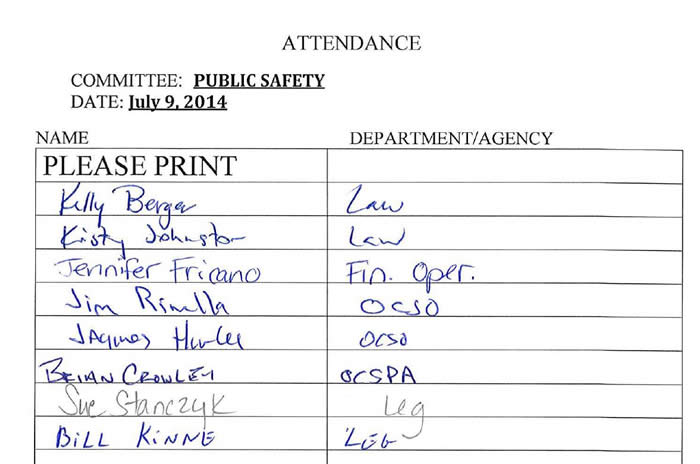
* * *
HEALTH COMMITTEE MINUTES - JULY 10, 2014
DANNY J. LIEDKA, CHAIRMAN
MEMBERS PRESENT: Mr. Corl
MEMBERS ABSENT: Mrs. Tassone, Dr. Chase, Ms. Williams
ALSO PRESENT: Also see attached list
Chairman Liedka called the meeting to order at 9:32 a.m.
Chairman Liedka stated there are not enough members for a quorum, so they cannot vote on any items, but there are some important topics that the committee needs to hear about.
1. HEALTH: Robert Stoppacher, M.D., Chief Medical Examiner; Michelle Mignano, Deputy Commissioner
a. Personnel Resolution – Reallocate the Salary Grade for Pathologist from Grade 37 to Grade 39, effective August 16, 2014, $113,875 - $150,961
Chairman Liedka said this item will be sent to Ways and Means.
Ms. Mignano:
Dr. Stoppacher:
- Today different than 5 yrs ago; when created, it was to be regional center, which hasn’t come to fruition until recently
-
2012 became accredited by the National Association of Medical Examiners - only office in NYS to be accredited; with accreditation comes requirements with staffing and limitations on numbers of autopsies that can be done
-
Expanded to Oneida County; taken on bigger case load; resulted in more work and the need for competent people
-
Chronically they have been to the Legislature to step increase people to hire; after many years, they are still on low end of pay scale nationally and in NYS
-
15 - 20% less than Rochester and Erie; as a result, the caliber of people to hire is less than desirable
-
If get quality, not able to retain; no room for growth in regards to salary
-
Looking to make efforts to recruit and retain higher caliber people
-
Office has become regional MEO for CNY; plan to continue to expand to Counties further surrounding
-
Need to get people and keep people; history of not being able to do; point is to alleviate that aspect of the issue
Chairman Liedka stated retention is vital, and asked if the goal is to expand upon neighboring counties. Dr. Stoppacher responded that they are not adverse to that, but they will need people in place. A Pathologist left, and since February have been trying to recruit, but have had no luck doing so. They cannot expand without covering the immediate needs. Chairman Liedka said that makes sense.
Mr. Corl asked if they have been looking since February, is the challenge a lack of interest or qualified individuals. Dr. Stoppacher replied yes; both. Chairman Liedka said if Onondaga County is the only accredited center, then the County should be getting blue chippers. Dr. Stoppacher commented that there are 500 – 600 board certified Forensic Pathologists in the United States, and the County is looking to have four (approximately one percent). There is a lot of competition, and despite the benefits of Central New York, other cities draw by what they are (i.e. NYC or Miami). The County’s MEO has made a name for itself in regards to quality, but if someone is choosing between Syracuse and a job in San Francisco for $250,000 (with a higher cost of living), they will probably choose San Francisco. Dr. Stoppacher stated they are not asking to be exorbitantly higher, but rather more competitive with the rest of the state. If someone had family in Central New York or Western New York, and their choice was Monroe or Syracuse, Monroe is paying twenty percent more with room to grow. Onondaga County is hiring four steps from the end of the pay grade with no room to grow. Dr. Stoppacher said the Deputy Chief stated she is at the end of the pay scale, and is actively looking to go other places, because she has nowhere else to go. It is an issue with retaining and recruiting people. Chairman Liedka said it’s a never ending process with training new people, then having the work back up. Dr. Stoppacher agreed, and said that it risks accreditation, because of the limits on the amount of autopsies they can do. It effects turnaround time, and if they are not meeting those requirements, then they have the potential of losing accreditation. Dr. Stoppacher does not want that to happen. Some centers have lost accreditation because of this issue.
Mr. Corl stated they cannot vote on this, but verbally Mr. Corl will recommend it. Chairman Liedka commented that it has to go to Ways and Means, and asked that Dr. Stoppacher give the presentation there. Chairman Liedka and Mr. Corl will send an email in support of this.
b. INFORMATIONAL – Vector Mosquito Control: Lisa Letteney
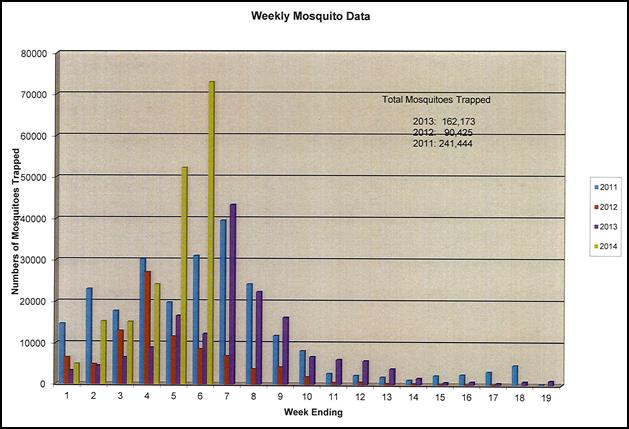
-
A lot of mosquitoes compared to last several years; based on this week’s traps, the numbers are going down; typical pattern for these; lots in early season, then goes down - virus does not correlate when there’s the most mosquitoes
-
No virus this year in Onondaga County; only virus found in NYS is Rockland County - West Nile in one mosquito pool
-
West Nile Virus (WNV) appears in early to late July; EEE in mid-august; expect to find every year, but not sure when
-
Largest traps in Cicero, 298 Island Road and Taft Road; Ley Creek and Oneida Shores are very large pools this year
-
2009 did spray by truck in Oneida Shores area; found EEE; keeping eye on that
-
22 traps cover County completely; 3 new – Grand Ave., Lakeland & Island Road DRB (dark resting box) – NYS Health Department asked to put this type of trap out; attracts blooded mosquitoes about to lay their eggs
- Not many in the DRB; CDC light traps get a lot
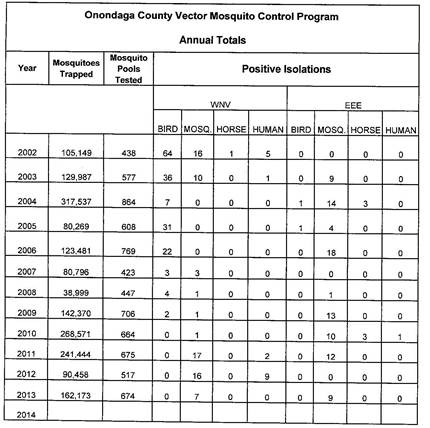 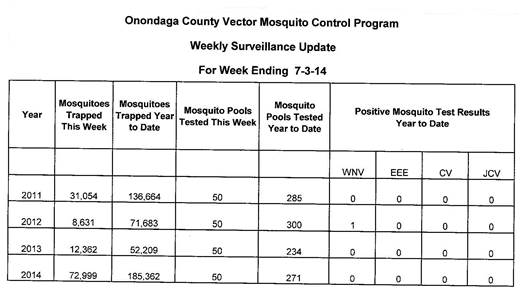
-
First chart above shows how many pools tested; also positives for WNV and EEE; second chart above shows the mosquitoes at the end of last week; up to 185,000 at this point, which is up there
-
Hard to tell if they will follow 2010 or 2011 with over 200,000, or 2004 with over 300,000
- Expect to find WNV and EEE; prepared to address when it occurs
Chairman Liedka asked if the number popped up because of the amount of rain. Ms. Letteney responded that it could be, but each year is unique (i.e. one year had a lot of rain and not a lot of mosquitoes). It could be the rain and the heat. Chairman Liedka asked Ms. Letteney to verify if there are twenty-four different types of mosquitoes, and if only a small amount carry disease. Ms. Letteney replied:
-
8 types of mosquitoes are honed in on, but they do look for other species like the Tiger mosquito - state asked the County to keep an eye out for it; people well trained to identify them, but they have not seen them yet
-
8 common including: canandensis and perturbans; little, biting mosquitoes everyone complains about; can carry WNV and EEE; generally see EEE in melanura
-
Have control program; larvae sited all catch basins in City of Syracuse - over 4,000
-
Larvae siting throughout the County at breeding sites – hold water for continued period of time; dip water to see if there is larvae, and if is, then apply a larvicide
-
Have done towns of Manlius, Dewitt, Cicero, Clay, Lysander, Salina, and the next will be VanBuren and Geddes; some places without a lot of breeding sites like Pompey and Lafayette have a few sites; also go by complaint
-
If resident calls with standing water on their property, or neighbor property, will go and address issue for resident
-
Have a lot of educational materials available for residents
-
-
Also tips for residents – what they can do on their own property to avoid mosquitoes breeding
-
Distribute brochures (available online) to numerous facilities throughout County including libraries, grocery stores, etc.
-
Staff always available to speak to any resident about mosquitoes and will address concerns
Chairman Liedka asked what triggers spraying, what procedures do they have to do, and what is the expense. Ms. Letteney responded if they find positive mosquitoes, then they will look at the population, what types of mosquitoes (human biters or animal biters), and what the weather is (if first EEE is in the beginning of October, not as concerned because it is getting cooler, and the mosquito population goes down). If there is EEE in a lot of mosquitoes, then they declare a public health emergency with the state, tell them what they found, and ask them to declare the emergency. They are able to spray at that point, and will hire someone; new contract with Clark. There are still some holdups for spraying sometimes with the weather, because they can only spray under certain conditions (wind below a certain amount and temperature high enough) for it to be affective.
Mr. Corl asked if they anticipate infected mosquitoes at the end of July. Ms. Letteney responded they could. Normally that is when they see WNV, and they will not spray for WNV. Typically they will not see EEE until mid-August; have seen it in July, but not typically. Mr. Corl stated it looks like they are on track to do more testing this year. Ms. Letteney said they started a week earlier this year, which could account for additional mosquito pools. The first week they submitted 30 – 35 pools. In previous years they had not started that early. Some of the initial weeks are training for summer help to identify mosquitoes, so that takes time. Mr. Corl asked how many people are on staff to do the testing. Ms. Letteney responded they have five students who count and identify mosquitoes, another five that do larvae siting, and three people on permanent staff. Ms. Letteney replied to Mr. Corl that they have a great group of kids that are very interested, and a variety that come back, so they are already trained. Mr. Corl asked if they budget for spraying. Mr. Zimmerman responded they budget for one spray, and there was a reduction in cost, so they have the potential for two. Mr. Zimmerman replied to Chairman Liedka that the cost was approximately $62,000, and the bid came in at $32,000 or $34,000. This covers 12,000 acres around the swamp. Mr. Zimmerman agreed with Chairman Liedka that it is aerial spraying. Ms. Letteney said the truck spraying only includes the staff’s time, and the chemicals are on hand already.
2. ADULT AND LONG TERM CARE SERVICES:
a. INFORMATIONAL: Heroin Epidemic – Robert Long, Commissioner
Kristen Stanton, Prevention Network; Roberto Martinez, Lerner Center; Gail Banach, Upstate New York Poison Center; Brad Finn, Prevention Network
 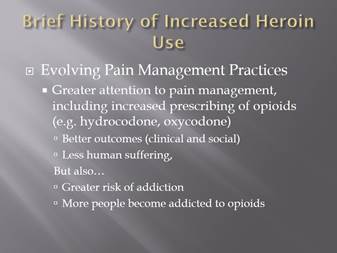
-
Anecdote: Mr. Long had minor surgery and physician prescribed oxycodone for pain post operatively; given 60 tablets and used 3; now 57 tablets to dispose of
-
Part of the problem, is those less informed will put the unused medication in their medicine cabinet, and if they have teens or young adults, then there is a risk that those kids will take the medication for recreational use
- Variety of ways people become addicted
 
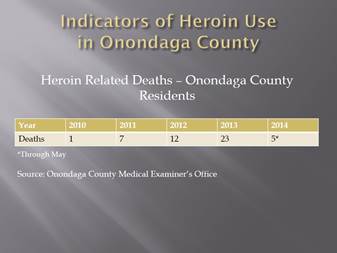 
 
- NYS rate in yellow, Onondaga County rate in blue – one of the highest if not the highest rate in the state
- Was flattening out; may be having some impact
Chairman Liedka asked if they identified why that is. Mr. Long responded that it could be availability, but not sure why the rate is so high. Mr. Long replied to Chairman Liedka that the hospitals are doing a better job at identifying newborns with drug related issues. Ms. Mignano commented that the hospitals serve more than just Onondaga County, so the hospitalization rate is not only Onondaga County residents. Neonatal services and children’s hospitals pull from surrounding counties. Mr. Long stated it is a regional center for twenty-three counties in New York State.
 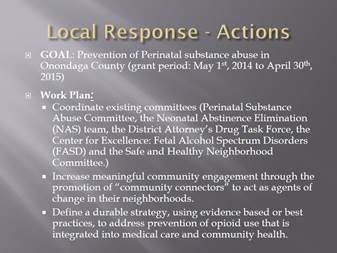
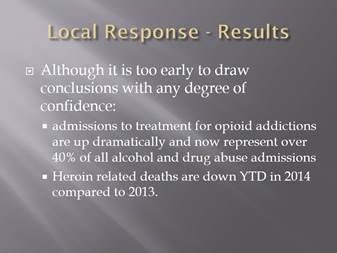
- Referrals to treatment going up; calls to the Poison Control Center related to opioid or heroin abuse are increasing
- 40 calls in 2012, 83 calls in 2013, 64 in 2014 so far (projected out would be 125 calls)
-
Some indicators that they’re getting a handle on this (deaths decreasing, getting more education, being referred to and accepting treatment); on the other hand seeing lot of overdose calls to poison control related to heroin abuse
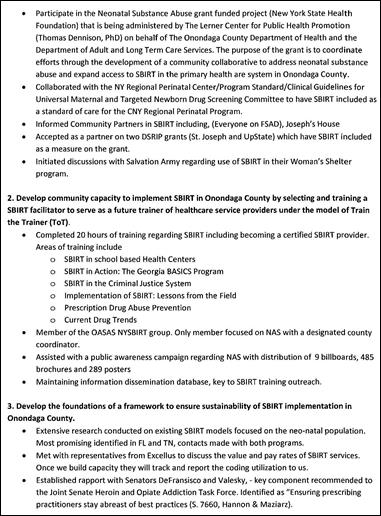 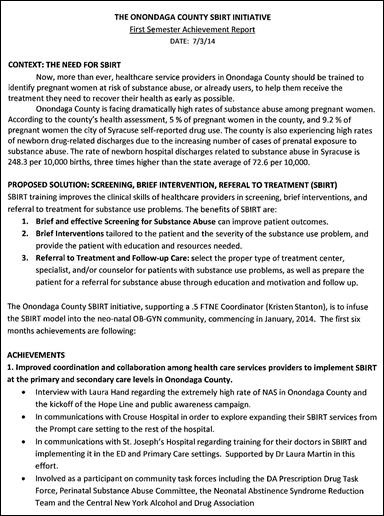
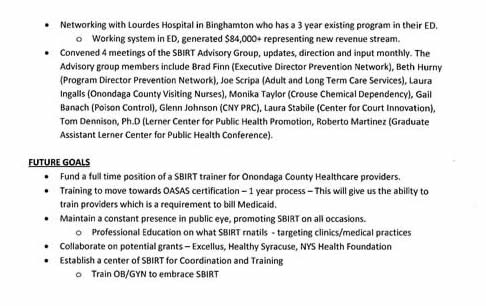
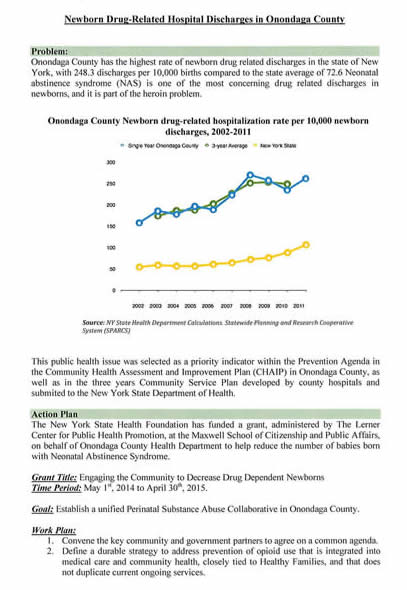
Mr. Finn:
-
Above shows what SBIRT has accomplished in the first 6 months; key point that Onondaga County had foresight to present and develop the SBIRT program - Office of Alcohol and Substance Abuse Services very interested
-
SBIRT looking at neonatal; will have greater impact on opiate population in general
-
Had funding and able to match funding to NYS Health Foundation Grant – will bring all the players together
-
Team (originally here for bath salts) still together addressing the opiate issue; now expanding
-
Phenomenal success so far; looking at best practices being initiated at OBGYN, family and primary care practices
-
Certainly addressing opiates to a point, but once system in place, will identify all types of drugs – better for community
Ms. Stanton:
-
SBIRT is not only catching those that already have substance abuse disorder, but those at risk for obtaining substance abuse disorder
-
Helping those that need treatment, and those that are borderline who didn’t know how high their use was
-
Address the issues, and show them if they continue on pattern, then this is where they could end up
-
Work with them before serious issue; catching a lot more people than only those that have substance abuse disorder
Mr. Martinez:
-
Community collaborative is main goal; working with Prevention Network; not one sided but backed by community
-
Important how mental community, policy members and different members of the community can come together
-
Come up with best practices according to what works and evidence it works in other areas
-
How can they intervene? What efforts can be done in the community to reduce neonatal substance abuse?
-
Important for opioids, substance abuse, alcohol and tobacco among pregnant woman (for example)
-
How can they bring the community, not only at level of policy makers or directors of organizations, to a better understanding of what they are currently seeing in Syracuse?
-
In order to better understand, need two things: (1) run statistics to see what they can learn from information provided by NYSHD; (2) what can they understand from the community itself; why is it happening in this community?
-
After getting the answers, then intervene in meaningful way to reduce substance abuse
-
Very exciting; interested in collaboration to communicate better
Mr. Long stated that branch started May 1st. They are getting things organized right now, which is why Mr. Long could not answer the question of why things are so much higher. It is one of the things they hope to find out.
Chairman Liedka’s perspective is that there are two problems: the heroin problem is one, and prescription drugs is another. Chairman Liedka tore his calf muscle last year, was given thirty pills, used one, and does not know how to get rid of them. They cannot be taken back to the pharmacy, and Chairman Liedka believes there should be education on how to dispose of them. Is there a way for the pharmacy to put a sticker on the prescription saying: if they do not use the prescription, then this is what you do with it? Chairman Liedka has heard that people go to open houses pretending to see the house, go through the person’s medicine cabinet and steal the drugs. There is an overabundance of those pills not being used for the right reasons. What can be done to educate people? Mr. Long agrees that they need to do a better job at educating people. There is a prescription take back program being organized by the state, where pharmacies will take prescriptions back on certain days. They have had one that was publicized. The other thing that is recommended is to mix the pills with used, wet coffee grounds, which will dissolve the pills making it so they cannot be picked out of the trash and used. Mr. Long said a lot of people do not know how to dispose of them, and there is a risk to putting them in the trash. They do not want them flushed, because it puts drugs into the water system and sewage treatment plants, where the drugs are not necessarily removed. The recommendation is that they go in the trash after mixing them with something that makes them unusable.
Mr. Finn:
-
DEA remains in control of how these drugs are collected and disposed of; working with Senator Schumer trying to get some changes at the federal level
-
NYS - illegal for pharmacies to take back controlled substance; level of access and ability
-
Most of garbage burned in County, so it is effective way to destroy opiates; don’t want people rifling through trash
-
Working with Walgreens and Kinney Pharmacy to come up with processes; possibly putting in kiosks in different locations to be collected by law enforcement and incinerated
-
Subcommittee on opiate heroin addiction putting together pending legislation to address some of the issues as far as education and prevention; have some solid movement at the state level as well
Chairman Liedka asked if it is natural for someone to go from prescription drugs to heroin. Mr. Finn responded if ten people were given alcohol continuously for a period of time, then a couple would be addicted. If they were given opiates for the same amount of time, then chances are eight of the ten would become addicted. Once someone becomes addicted, they lose the ability to get high, because they build tolerance. Most of those people turning to heroin are trying to stay off the withdrawal. When someone does overdose, they can be revived, but there has been unofficial feedback that people are shooting up more to try to reach a high again. They know someone will revive them with the narcan; narcan only has a half-life of four hours compared to the half-life of the opiate. What that means is someone will come back from their near death, feel fine and use again, when the opiate is still in their system.
Mr. Long:
-
I-Stop program was well intended; had positive impact on reducing amount of opiate prescriptions
-
Issue: some people who were addicted to prescription drugs can no longer get them, which drives the progression
-
If they are able to get the prescription and insurance covers the cost, then they will not turn to heroin
-
If they are no longer able to get the prescription and start buying them on the street, then the Oxycontin on the street is a lot more expensive; that’s when people begin to make that transition
-
There are natural endorphins in the body that are similar to opioids, which is why they work; trigger those receptors neurologically that are natural pain killers
-
When used chronically, the person has fewer receptors or they become dulled; neurochemical changes in the body is how they develop the tolerance; takes time for the changes to reverse themselves
-
Now the body’s natural state is to have the drug present; so the absence causes withdrawal, which is very unpleasant
Mr. Corl asked if they interact with the Office of Children and Family services to identify families at risk, or is there more collaboration between the two departments. Mr. Long responded they are working on more integration. The reorganization went the other way with separating children and adult services, but there is collaboration between the two departments, and they communicate on a regular basis. They also work with their partners who are child serving groups. Mr. Corl commented that it is good to identify those families with history prior to their being an issue. Mr. Long stated there is an easier ability to cross communicate and collaborate to recognize these issues across different departments.
Mr. Finn stated the brochure below is to reach moms who have not yet delivered. Once they deliver with a positive screen, then Child Protective Services comes in, and the mom is involved. They are trying to reach the moms before the fact, but have not been successful yet. They have a direct line to Crouse for moms, so they can call the number to talk to someone to get a brief screening intervention. If necessary, they will give the mom a direct pipeline to Crouse treatment, so there is no waiting.


Mr. Long said when they are dealing with children with prenatal or neonatal issues, they are dealing with the parents just as much. Mr. Corl stated the commissioners over the last five or ten years have worked hard to diminish the aura that DSS will come in and take the child away; rather than help. They are moving in the right direction. Mr. Long agreed with Mr. Corl, and said the real issue is to solve the problem not place blame.
The meeting was adjourned at 10:23 a.m.
Respectfully submitted,

Jamie M. McNamara, Assistant Clerk
Onondaga County Legislature

* * *
PLANNING & ECONOMIC DEVELOPMENT COMMITTEE MINUTES - JULY 10, 2014
KATHLEEN A. RAPP, CHAIR
MEMBERS PRESENT: Mr. Liedka, Mr. Corl, Mr. Knapp, 1Mr. Plochocki
ALSO ATTENDING: Chairman McMahon, Mr. Ryan and see attached list
Chair Rapp called the meeting to order at 10:39 AM. A motion was made by Mr. Knapp, seconded by Mr. Corl to waive the reading and approve the minutes of the proceedings of the previous committee meeting; MOTION CARRIED.
1. CONVENTION CENTER: David Holder, President, Steve Morgan, Chief Fiscal Officer
a. Informational: Report Regarding the Results and Finding of an Updated Lodging Market Analysis and Recommended Facilities Report for a Convention Center Headquarters Hotel
Mr. Morgan provide the following background:
-
Passed resolution accepting $1.1M from $15M State grant to be used for acquisition of Hotel Syracuse - Convention Center Hotel necessary to attract more visitors, County made these funds available to SIDA
-
SIDA also received $500k from the developer and used the funds to acquire Hotel Syracuse; progressed quickly owner didn’t contest eminent domain usage
-
Previous owner has compensation rights, funds transferred to the court for compensation
In answer to Chair Rapp, Mr. Morgan stated that $1.6m is now in the hands of the court and they will decide upon just compensation; no decision has been made as to the value. In answer to Mr. Knapp, Mr. Morgan stated that they don’t know if the funds will cover the compensation amount. The hotel value was appraised at $825,000. Chair Rapp added that they don’t anticipate the amount going beyond this. Mr. Morgan responded that he did not believe so.
- SIDA entered into a development agreement with Ed Riley, Senior Executive of Syracuse Community Hotel Restoration Co. 1, LLC prior to eminent domain action, property ownership transferred to them upon acquiring
- Resolution No. 65-2014 approved funding for market analysis to advance County strategy - develop Hotel Syracuse into Convention Center Headquarters Hotel; resolution requires a report to the Legislature of the analysis; market analysis went through competitive bid process led by SCVB, chose Pinnacle Advisory Group of Boston, same group provided the 2003 analysis
Mr. Morgan distributed the following report:
Space intentionally left blank
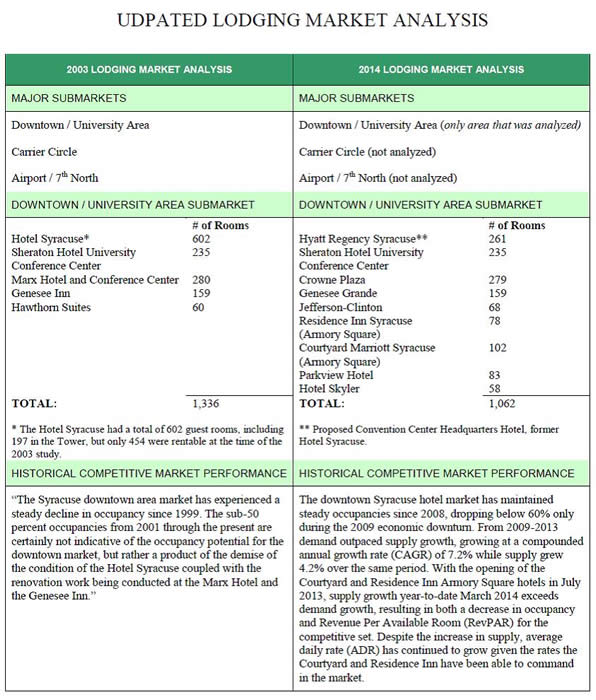
Mr. Morgan, Mr. Holder and Mr. Riley added the following:
- Less room supply in 2014 –total 1,062 rooms includes proposed project
- National trend supply outpacing demand, not specific to Syracuse; next page lists potential future supply additions
1Mr. Plochocki arrived at the meeting.
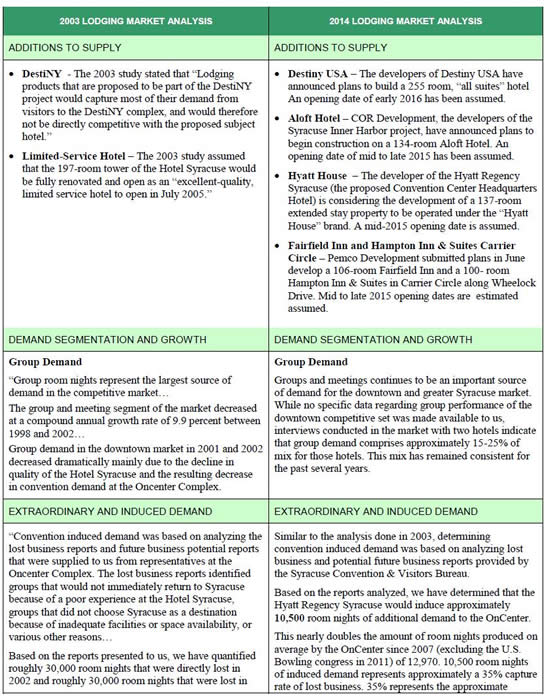
Mr. Knapp asked the difference in numbers from 30,000 in 2003 to 10,500 in 2014. Mr. Holder responded there were a few different factors in 2003:
- Were still selling the Hotel Syracuse as the Convention Center property with interest greatly waning, Hotel Syracuse closed a few years later, still tried selling Syracuse as a convention center city; numerous planners asked to be removed from their list until there was a hotel solution; have been able to pull some of that business back in, e.g. Public Employees Federation
- Sales process changed as a result, lost business list in 2003 were greatly expanded compared to 2014 - don’t go after business were they cannot compet
Chair Rapp asked if the 30,000 was potential business that they could go back to. Mr. Holder responded possibly – the length of stay for conventions is decreasing, which is a national trend. The big takeaway from this is that the hotel gives them a chance to double the amount of room nights coming into the convention center.
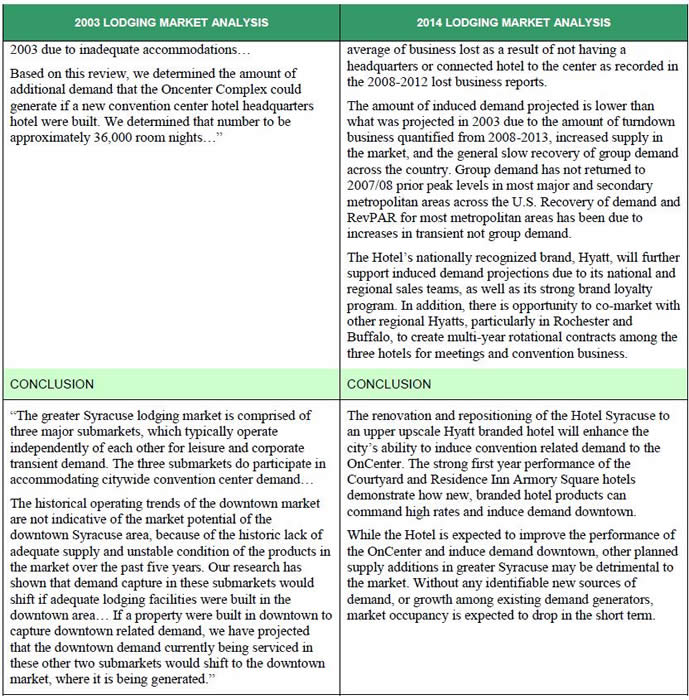
-
Not a normal hotel development, full service hotel with great capacity, adding to the marketplace and generating new business because of proximity to convention center - not simply pulling from others
Chair Rapp stated that this was an introductory meeting, an opportunity to get some of the facts out and digest them. She is not anticipating a vote of any kind today. This is their time to ask questions. Mr. Morgan added that this was just the start of the process. The next item on the agenda is a votable item but they are not looking for a vote at this time. They want to start discussing the agreements that need to be put in place to advance the project. Next, he will touch on at least one of the agreements and some of the major aspects of it, which is still in draft stage and being negotiated. As soon as the drafts are finalized, they will bring them to the Legislature for review.
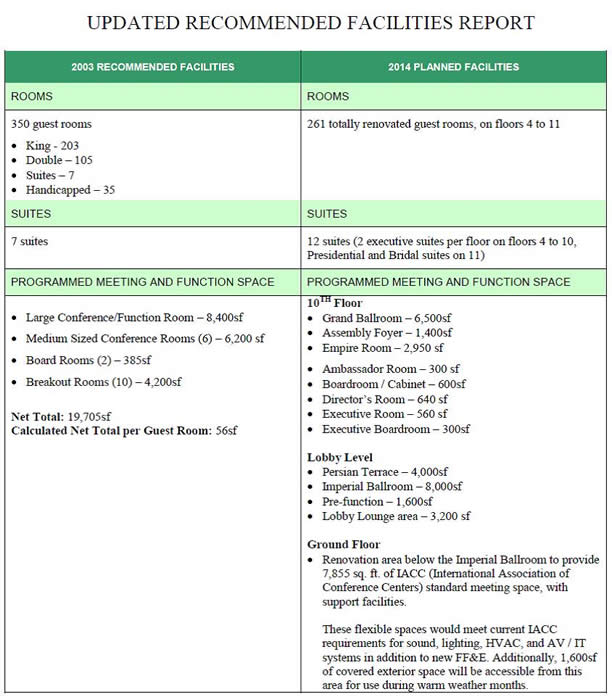

b. Designating the Former Hotel Syracuse as the Convention Center Headquarters Hotel and Authorizing the Execution of Agreements to Implement the Intent of this Resolution
Mr. Morgan asked Mr. Riley to go over the planned facilities. Chair Rapp asked that Mr. Riley and his team introduce themselves.
Mr. Riley:
-
Ed Riley, Executive with Pyramid Hotel Group of Boston, office in Boston, resides in the Town of Camillus, been with Pyramid 8 years and heads their Real-Estate Development Design And Construction Group, went to SU, is a registered architect, had an office in Armory Square
-
Has been to the hotel many times, has a lot of memories, watched it languish, decided it’s time to do something, fortunate to have this skillset, have done this with other hotels
Richard Engel introduced himself as a lawyer with Mackenzie Hughes.
Mr. Riley displayed photo plans for the hotel and provided the following:
- Historic hotel, on Salina, Warren, Onondaga and Harrison Streets, tower not part of the project; secured only the historic structure, doing standalone project, removing the bridge, bringing back main entrance on Onondaga Street coming up main stair to check-in
- Hotel will be renovated as an historic structure, have to utilize, maintain and market tax credits to make this possible; condition of main historic spaces makes this viable - lobby, Grand Ballroom, hallway doors
- Problem selling the hotel because of rooms; historic “coffin doors” and quarter walls will stay - only 2 other hotels in the world have these doors, everything inside the room will be removed, converting 2 rooms into 1, removing partition wall, keeping outside windows; current bathrooms very small, upgrading rooms is number 1 priority, will be all inclusive – fixtures, furnishings and equipment
- Group entrance down to lower level for check in behind the main stair, secondary entrance will feed Imperial Ballroom built in 1980; prefunction space very poor for the Imperial want to spill this over down to lower level with escalators
- 261 rooms, 2 floors above the lobby held for future inventory; floors 4-9 rooms to be updated, will have 2 doors on outside with 1 operating door inside, enter into a large sleeping area with pullout coach, expanded bathroom and small entertainment area with sink, using existing walls to the windows, contemporary furnishings; room total includes 12 suites - 2 Executive Suites per floor
- 11th floor Bridal Suite, spa, and rooms at balcony level of Grand Ballroom; social catering aspect of hotel is a huge business opportunity, used to wait 2 years for social catering, one reason the hotel can be renovated and made successful again; center section to be renovated into Presidential Suite with 4 bedroom, top floor has been neglected due to roof leakage, most hotels consider the top floor gold standard, want to bring this back
In answer to Mr. Knapp, Mr. Riley confirmed that all the plumbing and electrical rough-ins would be done on the two floors above the lobby. If those floors were executed it would bring the hotel to roughly 325-330 rooms; the biggest thing is demand.
-
10th floor former kitchen space converted into full fitness center with good views of the City, above this is the spa with inner communicating stair, all ties into social catering, bridal market, etc., Grand Ballroom will remain almost as is, all original chandeliers, lighting and controls will be upgraded, Empire Room to be redone, adding additional restrooms, boardrooms with original paneling and woodwork to be restored – important catering space
Chair Rapp asked when they could start booking. Mr. Riley responded that he would take reservations for March 17, 2016. Chair Rapp noted that St. Patrick’s Day has a legacy. Mr. Riley stated that it was a personal thing for him. He spent a lot of time singing at the lobby bar on St. Patrick’s Day and thought it would be a good day to reopen. His second choice would be New Year’s Eve. He doesn’t think he can make New Year’s Eve 2015, but thinks he has a good chance of making St. Patrick’s Day 2016.
-
Most of lobby level remains the same with 2 main stairways on Warren and Onondaga, addition of staircase and escalators coming from the main entrance below, additional prefunction space, Imperial Ballroom total redo to modern standards, Persian Terrace restored, main kitchen to remain and be restored, 3 meal restaurant serving hotel itself; proposing tenant space on 1st floor with sports bar and single seating high-end restaurant; main desk stays in current location - historic mural painted on back of wall, also have murals in Persian Terrace not sure what will happen with them, old bar will be removed brining the lobby back to its original configuration with more natural light
-
Ground floor to include 7,800 square feet of IACC meeting space, remaining area retail space
-
Elevation will stay mostly as is, connection will come off, top windows will be replaced, 2nd floor wood windows restored, store fronts restored, parapet rebuilt along with some of the terracotta
Mr. Knapp stated that the name Hotel Syracuse is going away. Mr. Riley responded, “big time”, because of the negotiations with Hyatt he cannot use the name at this time. The Hotel Syracuse moniker is not good. It is amazing how well known this hotel is. He has received emails and inquiries from as far away as California and Texas It’s an iconic hotel for its time and its architect is pretty well know; George Post and Sons oldest son designed it. In answer to Mr. Plochocki, Mr. Riley stated the name of the hotel would be the Hyatt Regency Syracuse.
Mr. Liedka stated that as far as self-contained meeting space within a hotel they would be ranked second in the city and asked how they would find a balance as far as partnering with the Oncenter verses becoming competition. Mr. Riley responded that one of the reasons they were adding the smaller IACC meeting space was for breakout space. The convention center suffers from a lack of small meeting space and they are trying to compliment it. An umbilical cord goes from this hotel to the Oncenter and back, they succeed only if the Oncenter succeeds. Until the Oncenter upgrades or gets new breakout space, this is what they can sell into. As far as ballroom space is concerned they would be in competition to a certain degree, but someone wanting the Grand Ballroom because of its aesthetics is a completely different animal than going into a large room for a banquet. Mr. Liedka agreed. Mr. Riley stated they were selling an experience to the room, e.g. Persian Terrace has elevated seating, wedding reception line is at right-hand side where you enter, people sit in elevated section in the back, head table for wedding party on left-hand side, band up on stage with dance floor in the middle. The Persian Terrace was originally the hotel’s restaurant when it opened. There were no doors from the lobby to the restaurant, it was all open space but the supper club didn’t work and they made it another room.
Chair Rapp asked how many people the room would hold. Mr. Riley responded that it is 4,000 square feet and could comfortably seat 400 people banquet style. Chair Rapp stated that there is really no competition. Mr. Riley responded that it wasn’t competition for the big rooms in the Convention Center. Chair Rapp added that the even the other hotels aren’t that big. Mr. Riley stated that the biggest competition would be smaller groups that could fit into either the Imperial Ballroom or a subsection of the Convention Center because both are very similar aesthetically. The Persian Terrance and the Grand Ballroom are aesthetically very different from anything else. Mr. Liedka added that they are one of a kind.
Chair Rapp stated that they are trying to get local business out of the Convention Center. Mr. Riley stated that they really want breakout space somewhere to help both of them sell meeting space and the like. Having this space at a high-level, with the right chairs, lighting, sound and technology is important. Part of IACC is to have food service also.
Chair Rapp stated to make all of this work they need 10,000 new people coming to town. Mr. Riley responded that they would need more than that.
Mr. Knapp stated that they were two blocks from the Convention Center and asked what the thoughts were for commuting back and forth, particularly in harsh weather. Mr. Riley responded, as a team. As a team, they have discussed various alternatives for getting people back and forth; number 1 is looking at streetscape all the way through and improving it. From a parking standpoint, the existing garage to the hotel is under separate ownership and is still in the hands of the group that used to own the hotel. He has left that alone as a hornets nest. In answer to Mr. Knapp, Mr. Riley confirmed an Israeli group owned the garage. Mr. Riley added that the Harrison Street garage will be used as their parking garage for a number of reasons. It is more modern, a better facility, and more user friendly. When the Hotel Syracuse garage was built 80% of business travelers were men, now it is 50/50 between men and women. Going to a very dark, claustrophobic parking structure, that needs a lot of work is not a good thing. Unless the garage has significant renovations, the Harrison Street garage is a much better option. The other issue is the condition of the garage given its age. The garage needs a lot of work across the board, not just to make it acceptable from a security and user standpoint but from a structural standpoint. The Harrison garage is underutilized and is located between the Convention Center and the Hotel. There is still a connection in the basement across Warren Street, surreptitiously through the money garage, over to an entrance of tunnel to the Convention Center by the War Memorial.
Chair Rapp asked if there was an opportunity to fix this. Mr. Riley responded that there was definitely an opportunity to clean it up and relight it. Chair Rapp asked if it could be widened. Mr. Riley responded that he would have to look at what they did when it was built. It was put in place when the MONY Towers was built. Chair Rapp noted that it was creepy. Mr. Holder agreed. Mr. Riley added that you are coming in at the lower level of the garage. Mr. Holder added that creepy doesn’t sell well to conventions. Mr. Riley stated that the tunnel underneath Warren Street and the access to get to this level in the hotel would need to be looked at. Currently you have to take the elevator down or a stairway that is not very good. A portion of the floor would have to be cut out to open this area up so that it is much more inviting and you don’t feel like a rat going through a maze. Then you will still have a problem when you get to the basement level of the garage, you enter and then have to walk among cars to get over to the other side.
Chair Rapp stated the best idea she has heard was a skybridge or glass walkway along the side of Harrison Street. Mr. Riley responded that they have done some studies in terms of what could be done on top of the Tech Garden. It would service both the Convention Center and the hotel. They could use the little tunnel as a way to cater this from their kitchens. They have looked at many different options and would definitely like to put those on the table. Chair Rapp noted that she was told this becomes a long walk when you are carrying two twenty-pound bowling balls.
Mr. Holder stated with regard to transportation, everyone needs to realize that there will still be massive use of other properties. Since the Hotel Syracuse has not been in operation, this community has gotten really good at shuttling and has received praise for it from Convention Center attendees. This hotel will not reduce the need for shuttling. The hotel will be another link in the showing process and will be a very important one. They will continue to factor in shuttling from the hotel to the Convention Center.
Mr. Knapp asked what they would be voting on at some point. Mr. Morgan stated that eventually they would be voting to designate the Hotel Syracuse as the official Convention Center Headquarters Hotel and authorizing the County Executive to enter into agreements. The two main agreements are the Convention Center Hotel agreement and a booking agreement. Both agreements are currently being negotiated with legal and both parties. Chair Rapp interjected saying that her thought was that once they have the drafts, and know what they are agreeing to. Mr. Morgan interjected saying that once the drafts are final they would be forwarded for their consideration and review.
Mr. Knapp stated that designating the hotel as the official Convention Center Hotel opens other funding sources. Mr. Morgan responded for the developer, correct. There is financing already approved by this legislature, funding from the state and additional funding that is available as well.
Chair Rapp asked when they anticipate the draft documents being ready for review. Mr. McCarthy responded that it was difficult to provide a deadline – a week, two weeks, certainly before August Session. Chair Rapp stated, “The sooner the better” and suggested they bring some legislators in on the negotiating process to assist in passage of the resolution when the time comes. Otherwise, it is almost unfair to bring the information forward the day before and expect a vote. Mr. Morgan responded that their goal is to get the documents in front of the legislature as soon as possible, so that there is plenty of time to review and discuss. Mr. McCarthy agreed. Chair Rapp stated that she would hate to go through this without allowing Legislators the opportunity to ask what if questions. In the end, it will just delay the process. Mr. Morgan noted this was the first step, getting the agreements before them and addressing any concerns will be the next step.
Mr. Plochocki stated that it sounds like a fixed plan for a physical link between the Convention Center and the hotel will not be in place prior to voting. Chair Rapp stated it wasn’t necessary. Mr. McCarthy stated that with the Weston Hotel, there was a specific resolution calling for a pedway and money was set aside for connection. There is no specific plan for this hotel. Mr. Plochocki stated that he took it for granted that this aspect would also be included for this hotel and was waiting to hear something more definite. Mr. Morgan added that moving forward they will be looking to repurpose the pedway funding for this project and will discuss this more as they get into the agreement. Mr. Holder noted that as the project moves forward they would sell it without a connection, only selling what they can assure they have. Chair Rapp added that if they are able to shuttle from Dewitt, they could shuttle from here. Mr. Holder stated that they would be shuttling regardless.
Chair Rapp asked Mr. Holder to provide an update on branding. Mr. Holder responded:
- Community branding outcome of 2012 Destination Marketing Analysis – recommended pursuit of true regional brand, move away from logo concept; made great progress and had some stumbles
- Unveil to community in August; BCF specializes in destination branding, clients include the State of Virginia, Virginia Beach, Aspen - Colorado, Rapid City - South Dakota, Alexandria - Virginia, Syracuse first northeast and urban area they have worked with
- Going after emotional appeal, were unable to capture geographical icon, BCF reversed the concept, multitude of aspects to destination, consumer connection based on what brings them here in the first place - visitors and residents have in depth love for area based on this connection
- Positioning statement – “The place where you can celebrate whatever passion you have”, provides stage to explore your passion and find many other things to do along the way, tagline “Do your thing”
- Next step execution - showing dynamic ways people use this destination, many imbedded subtle ways expressing this concept, e.g. photo of full Carrier Dome 3 runner each carrying a flag – 1st says DO, 2nd says YOUR, 3rd has image of foam finger with the word THING
- Struggled with logo capturing this identity, kicked back numerous ideas, want a platform to give to businesses and regional partners, something tying all destinations together yet maintaining their own identity; got first glance of concept yesterday, more work to do, similar to branding for Finger Lakes Wine Country with tagline of “Just down the Road”, homey approach which allows all businesses a way to play into the branding
- Ask for patience – getting ready to do something cool and bold, shapes ability to make incoming visitors feel warm, welcome and wanting to come back for more
Mr. Knapp stated that there isn’t one focal point here, like Niagara Falls, but there are so many individual things that this is a good direction to go in. Chair Rapp noted that this has been the challenge. When you see the pictures with “Do your thing” worked in, it’s pretty cool.
The meeting was adjourned at 11:48 AM.
Respectfully submitted,

KATHERINE M. FRENCH, Deputy Clerk
Onondaga County Legislature

* * *
WAYS AND MEANS COMMITTEE MINUTES - JULY 11, 2014
DAVID KNAPP, CHAIRMAN
MEMBERS PRESENT: Mr. Holmquist, Mr. Jordan, Mrs. Ervin
MEMBERS ABSENT: Mr. May, Mr. Kilmartin, Ms. Williams
ALSO PRESENT: Chairman McMahon, Mr. Ryan, see also attached list.
Chairman Knapp called the meeting to order at 9:55 a.m.
A motion was made by Mrs. Ervin, seconded by Mr. Jordan, to waive the reading of the minutes of the proceedings of the previous committee. MOTION CARRIED. A motion was made by Mr. Jordan, seconded by Mrs. Ervin, to approve the minutes of the proceedings of the previous committee. MOTION CARRIED.
1. SHERIFF: Chief John Balloni
a. 2014 Transfer Resolution – Custody
b. 2014 Transfer Resolution – Sheriff
Chief Balloni distributed the following updated overtime information; noting that that overtime Is not on the resolution. He reviewed the following:
2014 Sheriff's Overtime Projection (as of pp 14)
Police/Civil Custody Total
Overtime through pay period 14 ln 2013 |
$ 982,969 |
$ 1,268,518 |
$ 2,251,486 |
Overtime through pay period 14 in 2014 |
$ 679,858 |
$ 1,446,721 |
$ 2,126,579 |
% Change {2014-2013) |
-30.8% |
14.0% |
-5.5% |
Actual Overtime 2013 |
$ 2,130,312 |
$ 3,497,642 |
$ 5,627,954 |
Projected Overtime 2014 |
$ 1,691,820 |
$ 3,661,749 |
$ 5,353,568 |
% Change {2014-2013} |
-20.6% |
4.7% |
-4.9% |
Budgeted* Overtime 2014 |
$ 1,700,000 |
$ 3,100,000 |
$ 4,800,000 |
Variance (Projected - Budgeted 2014) |
$ (8,180) |
$ 561,749 |
$ 553,568 |
% Variance to Budget |
-0.5% |
18.1% |
11.5% |
* includes Adopted and Contingent
He noted that the variance for police/civl is on target; projected to be $8,190 under budget. However, one major case could bring up the $8,000 in a heartbeat. Major cases are built into the projections; projection should hold fairly true. Regarding Custody, with the new medical, the number of hospital details have gone down, cutting some overtime costs. However, $553,568 is projected over budget. Over all the total amounts are under the year before, but will well over budget for this year, given the budgeted amount.
Mr. Holmquist noted that the questions asked at Public Safety Committee regarding overtime have been answered. The items were severed at Public Safety, and questioned where the overtime resolution is. Chairman Knapp explained that since it was severed, and the overtime items failed at Public Safety, it was not put on the Ways & Means Committee agenda. Mr. Holmquist said that it was considered at Public Safety and the intention was to have it at Ways & Means Committee with questions answered. Mr. Jordan agreed, noting he thought it would be on today’s agenda as well, with getting the information in the interim. Chairman Knapp said that the information was available yesterday when going through the agenda yesterday. Mr. Holmquist said that hopefully that resolution would be available at session to be considered. Chairman Knapp said that he did not have a problem with that.
Mr. Jordan said that he asked for current balances of operating accounts at the Public Safety Committee. He asked why custody overtime is more than budgeted. Chief Balloni said that it is running at 110% of capacity. Chief Gonzalez said it is trending up, 14.9% above the year before. Last year they didn’t hire anybody; purposely didn’t have any academies –- looked at entire Sheriff’s budget and decided it was more important to look at staffing with the police side as opposed to custody. Mr. Jordan asked if there are fewer deputies in the Custody Division operating at the jail. Chief Gonzalez said they are currently up to capacity, as they just finished an academy after one year and a half on not having one; typically 2 academies are run per year. It is a six month process – get through academy and then FTO program. About 10 days ago they started getting the recruits off; for the 2nd half of this year an impact will be seen in overtime relative to their wages.
Chief Gonzalez said that CCS is doing a better job with medical as opposed to CMC. They opened an infirmary about 1.5 months ago and have an elevated level of training for the staff. They are not sending nearly as many people out to the hospital. In May there were 4 or 5 in patient hospital details out; in June there was one. When they go out, they don’t go out as often. When they do go out, they come back because wound care, sutures, etc., can be done in house. They have a more aggressive approach with the constant one-on-ones – making sure the constant observations are coming off more quickly. These things should have a positive impact on the 14% for the second half of this year.
Mr. Jordan asked about a projection on how much overtime will go down the second half of the year. Chief Gonzalez said that they are looking at asking for another academy, but it takes 90 days from when you call for the Civil Service list to when you can start an academy. In answer to Mr. Jordan, Chief Gonzalez said that they had retirements from the Custody Division in the last 1.5 years – sergeants, lieutenants and deputies. Every time a lieutenant or sergeant retires, a ripple effect occurs – promote up. Chief Balloni explained that there will be some balance in the regular payroll account in Custody – should be pretty healthy on the 101 line. The reality is that between payrolls and benefits (particularly health and retirement), it is still cheaper to pay to fill some of the positions with overtime than to hire. Because they are inadequately staffed, financially it is not profitable for the county to fully staff.
In answer to Mr. Jordan, Chief Balloni confirmed that there are excess monies in the 101 line at this point in time. Mr. Jordan questioned why there isn’t a resolution to transfer from 101 to overtime line. Chairman McMahon agrees that it is a balancing act; the legislature’s concerns are that when looking at historical piercing of the budgets in the Sheriff’s office, it is in the overtime line. When the legislature budgets a number, that’s the number. Getting to that number is up to the department. The reason the legislature has had to react and do things differently is because there has been a consistent piercing of the budget year in and year out.
Chairman McMahon referred to the Civil overtime budget, understanding that it is running below and doing well, and questions why contingency would be released. Chief Balloni explained that there is no money released to pay these funds; they are actually running in the red. Mr. Morgan agreed and explained that the legislature took regularly budgeted monies and put them in contingency – a good portion of the operating budget was put into contingency. Chairman McMahon asked why the legislature would basically give the Sheriff’s office all of it, and questioned asked what they are running a month on overtime in Civil. Chief Balloni said that the vast majority of police/civil, $1.7 million, is in contingency, which includes about $500,000 in pay, and were given $450,000. Chairman McMahon said that is saying that the overtime in Civil is about $80,000 - $100,000/month, and questioned why the legislature would give $825,000. Part of what the Sheriff’ office is doing correctly, and the legislature has been asked for, is to look at the services that the Sheriff’s office provides. If the legislature just gives $825,000, a faster growth rate than the current burn rate is, then the legislature is asking for problems. Mr. Morgan said that they are moving in the right direction and they will hopefully stay within their existing budget. They are trying to build somewhat of a cushion and not take the time and ask for another release in another month. Chairman McMahon said that the ask should be $600,000 for the rest of the year; asking for $825,000 is asking for more than what they average. Chief Balloni said that projections indicated that they need the full amount; at the end of the year they would need to pay all of the holiday pay. Chairman McMahon questioned why it would be released now. Chief Balloni said it can be done as the legislature sees fit; they literally have to come back next month to get the 4th quarter release to get it going for the following month’s vote. It is a question of when the legislature releases it.
Chairman Knapp asked that the transfers listed on the agenda be addressed. Chief Balloni said that the transfers basically represent 25% of balance held in contingency. The operating funds are being held hostage to deal with the overtime issue. Chairman Knapp said that it was detailed in Public Safety Committee; Mr. Holmquist agreed.
A motion was made by Mr. Jordan to approve item 1a, seconded by Mr. Holmquist. Passed unanimously; MOTION CARRIED.
A motion was made by Mr. Jordan, seconded by Mr. Holmquist to approve item 1b. Passed unanimously; MOTION CARRIED.
Chairman Knapp asked how the overtime piece can be addressed. Mrs. Maturo explained that it can be considered verbally. Mrs. Berger agreed that it doesn’t have to be in writing, and added that it was considered at Public Safety and can go to session. Mr. Holmquist said that it was in writing at Public Safety Committee. Mr. Morgan said that the numbers can be refined and will bring a resolution back.
Mr. Holmquist referred to discussion at the Public Safety Committee regarding Sherriff’s vehicles. It is not on the agenda today, but there is concern – heard from rank and file that there are possibly some emergency situations, and we should at least address something in the short term until the issue gets resolved with whatever the number is. Chairman McMahon said that the issue that the union was concerned about was because of a grievance. He doesn’t think it is a creation of this body, which has appropriated funds for vehicles ever since he has been here. Funds were appropriated for 2014 – it is one of the items that the legislature has discretion over and wanted to wait until further in the year to order the vehicles. Vehicles were ordered last year and the year before -- it is more of a fleet management decision by the Sheriff. September would be an appropriate time to dive into this – good data would be available on some of the other numbers in the budget; there will be pressure to pierce overtime in the summer months.
Chief Balloni said that in 2011 the legislature appropriated $0 for vehicles; the current rate of replacement based on fleet size is 10+ years. No one in the business drives vehicles for 10 years. The appropriation is inadequate. He said the the union did not file a grievance, they went to PESH, who is saying the vehicles being supplied are unsafe and unfit to drive. Chairman McMahon said that the reality it that the legislature has been giving money for vehicles each year, and will this year, but wants to see that the Sheriff’s department lives within the budget that they have to by the charges set by this county, which they have not been doing. Mr. Holmquist said that something has to be done; there are people who are not directly involved saying that this is a problem and a safety issue – it is something that needs to be addressed.
Chief Botsford said that part of our role is to provide the tools people need to do their jobs. Our people are out there making emergency responses, 24 hrs/day in vehicles that are becoming unsafe. Some vehicles do not have floors in them. These are cars used for emergency responses; we must provide the tools needed to do the job and put politics aside. The men and women of the Sheriff’s office deserve the tools to do their job safely, and we are failing them – it can’t continue. He has been on the job 37 years and has never seen the fleet in this condition. It is because of politics and it has to end. Chairman McMahon asked what is political about a $2.7 million budget piercing. Chief Botsford said that if the cars were ordered now, they couldn’t get them until next year. Chairman McMahon reiterated his question; noting that the legislature is addressing the facts that Chief Botsford and the department had something to do with. For years, people have said to look at the menu of services that are offered, and what can be done about it, what can be more efficient. This year the legislature took extraordinary procedures, and the Sheriff’s Department made tremendous progress. Now they are asking the legislature to undo potentially all the progress that has been made. He noted that when the monies are given to the Sheriff’s Department year over year, they make the decision on what cars are being purchased, not the legislature. The Vehicle Review Board makes the decision, not the legislature. This isn’t politics; it is a reality that the Sheriff’s Dept. budget has gone over for the last three years substantially.
Chairman Knapp noted that the overtime portion was considered and can go forward at session.
2. HEALTH: Michele Mignano, Acting Commissioner, Dr. Robert Stoppacher, Medical Examiner
a. Personnel Resolution – Reallocate the Salary Grade for the Pathologist title from gr. 37 to gr. 39, $113,875 - $150,961
Ms. Mignano:
- Have been unable to keep, recruit a full cadre of medical professional in the MEO for the past 10 years
- When pathologists are hired, they are advanced stepped
- Want to be able to recruit and retain – put in a salary schedule that is remotely close across New York State
- Have been recruiting for 4 months; have only had 2 bites and lost them before they even got here to meet Dr. Stoppacher
- Seeking anywhere they can to contract in order to fulfill needs to provide services
Dr. Stoppacher:
- Have had a lot of difficulty keeping a full staff; come to legislature many times to step increase people
- Have had contract pathologists for 8 years because can’t fill the position to the extent they need to be
- Nationally about 500-600 board certified forensic pathologists in the whole country
- CNY/Syracuse is not a draw for most people unless they have a reason to be here (i.e. have family or grew up here)
- Issues with salary – it is 15-20% below competition/corresponding colleague in Erie or Monroe Counties
- Greater discrepancies among larger cities
- To get by, have filled in with contract pathologists – fill a void
- In 2012 changes in office – nationally accredited – right now the only fully accredited office in NYS
- Accreditation means that there is ability to get more grants; can hire new graduates – need to be recertified and many need to be working in an accredited office; offers creditability
- Accreditation comes with specific requirement on autopsy numbers
- Accrediting body states that no pathologist should be doing over 250 autopsies/year
- Beginning In 2012, took over Oneida County, do approximately 1,000 autopsies/year as an office – it will risk accreditation
- It puts a damper on current staff – overworking them; will look to go elsewhere if it continues, as the level of work is not sustainable
- With Oneida contract it became more of a regional center – have to fill the contract and need people to do the job
- This year a pathologists left for a different job; have tried to recruit for 4 months – had 2 potential candidates who took jobs elsewhere for higher salaries
- Wish to raise salary for recruitment process and retention for the future
Mr. Jordan asked if an analysis has been done regarding the continuation of filling the void on a contract basis instead of hiring a new pathologist. To hire someone, there are all the benefits that go along with it, which can be 40% above and beyond salary; may be better to go with contract pathologists so we don’t have all of the costs associated with hiring someone. Dr. Stoppacher said that it may be the case purely from an economic standpoint. Although most contract pathologists charge between $2,000 - $2,500/day. The lack of benefits from having contract pathologist: they are only there 3 days/week; gone for follow up; notorious for bad turnaround time because they are not there to follow up on cases. Turnaround is a big thing with respect to accreditation. It is feasible from an economic standpoint, but doesn’t think it is the best option – not the path if truly trying to be a regional center. Ms. Mignano said that contracting for pathologists never intended to be a long-term process; long term really changes the office.
Chairman Jordan referred to the contract with Oneida County and asked if there is is a provision in the contract that says that if the cost of pathologists increases, then the reimbursement from the other county increases as well. Dr. Stoppacher said specifically in the contract with Oneida County, there are four positions within the ME’s office that are specifically paid for by Oneida County.
Chairman Knapp asked about work done for other counties. Dr. Stoppacher said that they basically do all the autopsies for Oswego, Madison, and Cayuga Counties; it is not in the same form as Oneida. In answer to Mr. Jordan regarding increasing reimbursement from these counties, Dr. Stoppacher said that they typically raise the fee schedule every 3 years by 5%–10%, but it is not directly linked to hiring one person – it is an across the board type of arrangements. It is not contractual to raise it; it has been the policy. Mr. Jordan said that it could be increased if chosen to, given increased cost. Dr. Stoppacher said that they could; the risk is that a county could say they wouldn’t pay that cost and send autopsies somewhere else.
Chairman Knapp asked where the contract pathologists come from. Dr. Stoppacher said that most commonly they use a doctor out of Binghamton. Most recently they are using a retired ME from Cazenovia, who has very limited availability. Other options have been looked at, i.e. someone from NYC, but it is almost cost prohibitive with travel expenses.
Chairman Knapp said that Dr. Stoppacher has built a tremendous reputation and facility and recognizes the risk of losing everything that has been done up to now. Mr. Holmquist agreed and feels a move should be made on this finally.
Mr. Holmquist asked that someone in the room tell the County Executive to cease and desist with the “absurd and reckless Health Department reorganization proposal.” No one in the community supports this who doesn’t work for the County Executive directly. His concern is that when it is proposed, it will be a complicated web that Mr. Morgan will be all tangled up in--trying to push the budget through. It is unnecessary – it would be two months of wasted county assets. Ms. Mignano said that the message will be taken back and thanked him for being passionate about the Health Department. She said that this is in the early process; where it all ends up and lands is still in process. They know that they can improve on ways to work with collaborative partners in the community and with peers and colleagues within the County. She would like to further the collaboration; it is a good thing; and something they are all supportive of. Mr. Holmquist said it is a waste of money; there has to be a single medical professional in the community that supports this outside of the people that work for the County Executive, and there are none.
A motion was made by Mr. Jordan, seconded by Mrs. Ervin to approve this item. Passed unanimously; MOTION CARRIED.
3. CONVENTION CENTER HOTEL: Steve Morgan, CFO; David Holder, Conventions and Visitors Bureau
a. Designating the Former Hotel Syracuse as the Convention Center Headquarters Hotel and Authorizing the Execution of Agreements to Implement the Intent of this Resolution
Chairman Knapp said that this was discussed at the Planning & Economic Development Committee yesterday; it is still in flux and will not be voted on today. He noted the following were present: Ben Walsh, City of Syracuse; Richard Engel, Attorney with Mackenzie Hughes representing the developer; Ed Riley, Developer of Hotel Syracuse.
Mr. Morgan:
- Legislature approved acceptance of $1.1 million from NYS from a $50 million state grant. It was forwarded to escrow to allow SIDA to proceed with acquisition of Hotel Syracuse through eminent domain. Also, Mr. Reilly put up $500,000
- $1.6 million now sits and waits for court to decide just compensation for the property
- SIDA took ownership of it and transferred ownership to Ed Riley, who now has title
- Legislation is to designate the hotel as the official convention center headquarters hotel
- Seeking authorization for two agreements:
- Convention Center Headquarters Hotel agreement – details are being negotiated and finalized – when it is in draft final form, it will be forwarded to the legislature for review/consideration. Hotel agreement requires County to secure state grant and pass it through for construction costs, as well as a $1.25 million SIDA grant, which has been there for years
- Booking agreement – being negotiated – when final draft is available will be forthcoming for review/consideration. Will gnat County/CVB certain booking rights – a certain amount of rooms at a certain price
Mr. Walsh addressed the financing:
- SIDA was able to take title through eminent domain last week – have clear title
- “A $60 million project that supports about not much more than $20 million in tradition debt” – it is a big gap to fill. A number of ways to do that: additional equity on behalf of development, historic tax credit, public subsidy in the form of grants – some lined up already; some are being lined up now
- When considering the amount of public subsidy being put into this project, which shouldn’t be taken lightly, it is important to consider the alternative. County has a performing asset in the Oncenter, believes this will assist in being more productive for the County. City’s perspective – scare that the hotel will go through another winter without the heat up; demolition will be upwards to $10 million that the taxpayers would end up on the hook for, if the building were left abandoned.
- Looked at alternatives, looked at importance of projects and long term benefits, feel it well worth the investment
Chairman Knapp asked if there will be a PILOT from the City. Mr. Walsh said “yes”’; have yet to fully negotiate the details of the PILOT. SIDA has a uniform tax exemption policy that articulates the different PILOT options based on specifics of the project. It would need approval from SIDA and Common Council; expect to bring it forward in August. Looking at the operating budget going forward, the relief on increase of property taxes is an important part of the equation. In answer to Chairman Knapp regarding mortgage tax, Mr. Walsh said that SIDA has already induced the project and through it are providing mortgage recording tax exemptions and sales tax exemptions on construction materials.
Mr. Jordan asked what the anticipated county participation is to the project. Chairman McMahon said that the $15 million that was earmarked for the Convention Center Hotel, for the last decade, is still there. A piece has been advanced to help with the acquisition. Essentially the remaining balance of it would be asked for the project. Mr. Jordan said that the $15 million is State money. Chairman McMahon agreed and said that in addition there is $1.25 million grant that is in a project account for this. The developer has been working with the State’s Regional Economic Development Council for an additional $4.7 million. The developer needs the designation to help with financing and room block agreement, which also helps the Oncenter. Mr. Jordan clarified that the County contribution would be the $1.25 million grant and the room block agreement. Mr. Walsh noted that the $1.25 million are funds that actually came from SIDA. It was originally for the pedway; SIDA will revise the initial resolution authorizing that grant specifically for this project.
Mr. Riley noted that except for the REDC application, which they put in a couple weeks ago, all of these grants were previously approved with other development/projects. They are asking to consolidate/corral them so that they can be used on the Hotel Syracuse development. The main reason for the REDC is because the originally planned on using another financing mechanism (new market tax credits) in the process, which fell out, and had to find another mechanism.
Mr. Jordan said that it is a great idea; it is a beautiful building and landmark for this area; glad to see it move forward.
In answer to Chairman Knapp, Mr. Riley said that because it is being renovated under the guidelines with the National Preservation Historical Act, they will take advantage of the state and federal historic tax credits. It is a big inducement with financing; looking for a financial institution that wants those tax credits. Because they are renovating as a hotel, they get a very high percentage back.
Mrs. Ervin said that she loves the project; great idea to save the Hotel Syracuse, but there has always been a strong opinion that a hotel was needed near the convention center. She asked if this project negates going forward with a plan in the future to build another hotel. Chairman McMahon said that the market study says that this is the last development for a hotel in the near term for a downtown market. It gave recommendations for potential usage of the parking lot – including retail space, arena, residential. The downtown hotel market has done a good job – steady occupancy rates and good room rate growth, but there isn’t as much of a need for further downtown hotel development. Mr. Holder said that that market analysis says that based on the Hotel Syracuse coming back on board, 261 rooms, the amount of overnight business going into the convention center will be doubled. The convention business has changed greatly since Hotel Syracuse closed the first time. In answer to Mrs. Ervin, Mr. Holder said “who knows what the future is going to hold”, this gets us to a solution of needing a convention center hotel, in good proximity to the convention center, with amenities, one that brings the Hyatt label. Hyatt is an enormous convention center related hotel; can bring tools to the table that we don’t have as a community.
Mrs. Ervin asked for clarification to her question and further asked if in the future there will be a possibility of discussing putting a hotel closer to the convention center. Chairman McMahon said that there is assuming policy makers around this table think there is a need, but it looks like in the next 5-6 years that it wouldn’t be a wise investment. Mr. Holder said that if we make this as successful as we want to, then hopefully there will be another hotel in the future too.
Mr. Jordan referred to the tunnel that exists that connects the Hotel Syracuse to the Oncenter, and asked if there is any prospect of developing it. Mr. Riley said that it is still there, but it is a very circuitous route. They can go down there and make it better; dress it up with better lighting, finishes, etc., but can’t change the size of the tunnel. The better method is walking outside; it is a quick walk. Also, they are looking at the garage attached to the Hotel. It is very old; the deal with the City is to use the Harrison St. garage, which wasn’t there years ago. It is between the Hotel and the Convention Center. Given that, with a shorter walk and dressing up the way to get from the Hotel to the Convention Center, it will do a lot. Mr. Holder said that they need to do community planning on how to make the distance between the hotel and convention center as friendly, inviting, and hospitable as possible. He does not see the tunnel as being a future for us. Mr. Jordan said that when he was the Planning & Economic Development Chair, the marquee argument was that people wanted to be able to go from the hotel into the convention center without having to go outside. Facilities that have that will be preferred over our location.
Chairman Knapp said that that shuttling was discussed at the committee meeting yesterday--have become very good at it, and it is an option. Mr. Holder agreed; it won’t go away. With the plan of 261 room count, there will be a number of spill over properties that will part of convention blocks; shuttles will be run regardless.
Mr. Jordan added that the beauty of the facility in and of itself certainly has its own attraction.
Chairman Knapp said that Mr. Riley provided a very in-depth, floor by floor, review of the plans. It looks like it will be done the way we have always wanted it to be done. In the past it was Band-Aids and half measures.
4. MISCELLANEOUS:
a. Designating Onondaga County as a Purple Heart County (Sponsored by Mr. McMahon)
Chairman McMahan:
- Local veterans groups have reached out to to make Onondaga County, and other counties, Purple Heart Counties
- Approached him in early spring; thought this was more of an appropriate month, as Aug. 7th is Purple Heart Day in the State of New York
In answer to Mr. Jordan, Chairman McMahon said that this is a special recognition for veterans who have achieved the honor in their service.
A motion was made by Mrs. Ervin, seconded by Mr. Jordan to approve this item. Passed unanimously; MOTION CARRIED.
b. Exploring the Usage of Take Home Vehicles and Requesting an Audit be Conducted (Sponsored by Mr. Ryan)
Mr. Ryan:
- Discussion about this came out of Vehicle Use Review Board last budget session
- Had a lot of questions; wants to get arms around take home vehicles – what is out there; what they are used for; where resources can be applied; is it efficient/smart; is it a good use of resources and taxpayer dollars
- Has worked in conjunction with Legislature Liedka, Chair of VURB
- This isn’t a witch hunt to take county vehicles away
- Looking for mileage, who is taking them home; number of times used in last 12 months
- Need an understanding that if there are vehicles being taken home and not used, taxpayers are incurring expense, then there has to be a serious conversation as to whether that vehicle should be taken home
- Timely to get information back – to have information going into budget time
Mr. Holmquist said that logistically if this passes August 5th, will a form go out to employees that have take-home vehicles to fill out and return by a certain date. Mr. Ryan said that the intent would be that it would go to the department head. He noted that at timeframe needs to be established for the department to return the information. Mr. Holmquist expressed concern about the timeline, and asked if it will affect the budget; will we get it by then. Mr. Ryan hopes to have the information by then; if might effect the number of vehicles being requested. Mr. Morgan said that he doesn’t know how much the review of take home vehicles will impact the budget. They question here is “why are they going home?” He doesn’t think it’s a question of why the vehicles are in service. Mr. Holmquist asked if the VURB will have the information, as they meet at that time. Chairman Knapp said that VURB meets at the end of the budget cycle, which gives a little more time.
Mr. Jordan said that a lot of this information is already available. It is discussed year in and year out. Chairman Knapp said that the key piece of this is that we have the sterile numbers of the take home cars, but we don’t have the utilization. We also don’t have the information as to whether a vehicle is a contractual obligation, where we don’t have leeway.
Mr. Ryan referred to the contracts; there is one in a sense settled; the rest are currently being negotiated. Mr. Troiano said that there is a tentative agreement on one; all others have expired and are in negotiations, not counting the tentative agreement as a request of arbitration award. There are information sessions going on now. Mr. Ryan said that the timing is good, as we are in the process of negotiating agreements and can work this into an agreement. He has heard about past practice; it is a gray area. Even if it is a past practice, and not a good past practice, we should be looking to change it.
A motion was made by Mrs. Ervin, seconded by Mr. Holmquist to approve this item. Passed unanimously; MOTION CARRIED.
Chairman Knapp said that between now and session a time line needs to be added to the resolution.
5. FINANCE – MANAGEMENT & BUDGET: Steven Morgan, CFO
a. INFORMATIONAL: Room Occupancy Tax
Chairman Knapp said that ROT is a big number. In speaking with a few legislators, it was thought to be worth the time to have Mr. Morgan talk about where it has been, where it is going, trends and utilization.
Mr. Morgan provided the following report and noted:
- Legislation establishing ROT was in 1975 to “promote Onondaga County, its city, towns and villages in order to increase convention, trade show, and tourist business in the County”
In answer to Chairman Knapp, Mr. Morgan explained that the tax is 5% of the room fee. In answer to Mr. Holmquist, Mr. Morgan said that the establishing legislation was a local law.
-
The legislation states that “all revenues resulting from the imposition of the tax under this local law shall be paid into treasury of the county and shall be credited to and deposited in the general funds of the county; and shall thereafter be allocated at the discretion of the Onondaga County Legislature to further the intent of this legislation…..”
-
The process used to appropriate this tax follows that--County Executive proposes the uses of those funds; the legislature reviews them and approves or denies them
-
Any potential uses of surplus comes over in resolution, that that the legislature vets, approves or denies
Room Occupancy Tax Revenue - 2009 - 2014 projected |
|
2009 |
2010 |
2011 |
2012 |
2013 |
2014 (Projected*) |
Adopted |
$5,250,000 |
$4,781,190 |
$5,450,000 |
$5,464,185 |
$5,900,000 |
$6,247,846 |
|
Actual |
$4,957,336 |
$5,441,020 |
$5,725,847 |
$5,840,650 |
$6,240,926 |
$6,305,267 |
|
Variance |
($292,664) |
$659,830 |
$275,847 |
$376,465 |
$340,926 |
$64,341 |
|
*Projection includes 2014 first quarter actual revenue received |
|
|
Chairman Knapp asked what happens, i.e. 2009, when there is a collection below the adopted. Mr. Morgan said that he wasn’t here then, but assumed there was a ROT fund balance. If there wasn’t one specific to ROT, then it would have to be taken out of general fund.
Room Occupancy Tax Appropriations - 2014 Adopted Budget |
ADMINISTRATIVE COSTS |
|
Comptrollers Office |
$49,433 |
Law Department |
$34,705 |
Finance Department |
$83,249 |
Management and Budget |
$26,620 |
Sub-Total |
$194,007 |
|
|
AUTHORIZED AGENCIES - FINANCIAL |
|
CNY Arts |
$697,666 |
Contingency |
$405,000 |
Landmark Theatre |
$50,000 |
Sub-Total |
$1,152,666 |
|
|
AUTHORIZED AGENCIES - HUMAN |
|
St. Patrick's Day Parade |
$15,000 |
|
|
AUTHORIZED AGENCIES - PHYSICAL |
|
Baltimore Woods - Center for Nature Ed. |
$12,500 |
|
|
COUNTY GENERAL OTHER ITEMS |
|
Contracted Services |
|
Syracuse CVB |
$1,250,000 |
Syracuse Nationals |
$25,000 |
CenterState CEO |
$ - |
Contracted Services - Total |
$1,275,000 |
Onondaga Historical Association (OHA) |
$158,555 |
Erie Canal Museum |
$60,005 |
Contingency |
$375,000 |
County General Other Items - Total |
$1,868,560 |
|
|
OTHER DEPARTMENT ALLOCATIONS |
|
PARKS (GRANT #77044-002) |
$35,000 |
PARKS Carp Brook |
$50,000 |
LEGISLATURE - Tourism Incentive |
$175,000 |
Other Departments Total |
$260,000 |
|
|
ONCENTER REVENUE FUND |
|
Oncenter - Operating Subsidy |
$1,500,000 |
Oncenter - Capital Reserve Fund |
$250,000 |
Oncenter - Charges from FM |
$972,972 |
Oncenter - Charges from Law |
$22,141 |
Total Oncenter ROT |
$2,745,113 |
|
|
2014 Adopted Distribution Totals |
$6,247,846 |
-
Supplied 2014 adopted, approx. $6.3 million and what was approved by the legislature for those dollars
-
Administrative Costs – costs they look to cover for the administration of this tax: Comptroller – a lot of audit work, making sure the amount submitted is accurate that is owed to the county; Law Dept. is involved with everything- take revenue to support them; Finance/Management and Budget – handles all of the administration work associated with ROT – receive payments, process checks, get them into the accounting system, ensure people are paying, follow up, file liens if necessary, etc.
Chairman Knapp asked where the Symphony allocation is. Mr. Morgan said it is in CNY Arts – contingency.
Mr. Morgan explained that with the Oncenter Revenue fund – those charges from Facilities are charged to Oncenter revenue fund; that revenue no longer supports Facilities budget. For years Facilities incurred costs associated with the Oncenter and it would be supported partly with ROT revenue.
Chairman Knapp asked what the difference is with charges from Law (Oncenter) and the administrative costs. Mr. Morgan said that the charges from Law are specific to a significant amount of work with getting the SMG contract in place; there is a two year lag in terms of interdepartmentals.
|
|
Room Occupancy Tax - Balance from Prior Year Surplus |
|
|
2014 ROT Fund Balance as of 1/1/14 |
$1,185,250 |
2014 ROT Fund Balance Appropriations |
-$655,000 |
Current ROT Fund Balance |
$530,250 |
|
|
2014 ROT Revenue Projected |
$6,305,267 |
2014 ROT Appropriated |
$6,247,846 |
Projected Surplus |
$57,421 |
|
|
Current Balance + Projected Surplus |
$587,671 |
- Subsequent allocations approved by the legislature: $500,000 Lake Revitalization Project; $155,000 of direct appropriation out of fund balance during the budget process (Landmark, Red House, Syracuse Film Festival)
Chairman Knapp said that he realizes there is a lag with collections, but asked how we are doing so far this year. Mr. Morgan said that they are projecting it to be pretty much on budget. There have been some hotel groups that have become particularly delinquent; it has been a challenge to chase down the funds. There are legal remedies for it; and are used as needed. At the end of 2013, there were some fairly large receivables outstanding – had to book an accrual at the end of the year to account for it.
Chairman Knapp said that the information is very informative; Mr. Holmquist agreed said that it very appreciated. He feels that legislators should get a copy of the local law and review it, review everything from ROT from the collection of it, the budget, and process, and use the proper mechanism to possibly amend the law, process, or priorities. It is a lot of money; need to keep an eye on the proper uses of ROT. The appropriate use of ROT to drive the revenue is important.
Chairman Knapp said that he is curious about a seeing a historical look at what it has been used for.
6. LAW: Gordon Cuffy, County Attorney
a. Personnel Resolution - Advance step to change the incumbent (R.P. 01 104700 9853) First Chief Deputy County Attorney from Grade 38 Step M @ $109,578, to Grade 38 Step W @ $123,888, effective the first payroll period after August 5, 2014.
Chairman Knapp said that this is a new item and doesn’t anticipate taking a vote on it today; it will be considered.
Mr. Cuffy:
- This is a return to the salary for the First Chief Deputy County Attorney
- Have not had the a First Chief Deputy County Attorney since 2010
- Due to the complexity of some of the issues today, and a continuing effort to upgrade the Law Dept., he felt the position needed to be filled
- Someone to handle some of the more complex issues and help him supervise some of the more involved economic development issues and more difficult litigation issues being faced
- Filled the position of the First Chief Deputy County Attorney--that person is now in a position where supervising people who are making more than her
- The upgrade is a return to the salary what the First Chief Deputy County Attorney made in 2010
Mr. Holmquist said that he didn’t know that this was going to be on the agenda; assumes it was a late addition and doesn’t care for that unless it is an emergency. He doesn’t like when things are added at the last second; there are rules about getting things in on time so that legislators can talk about items and have discussions rather than walking in and reading it for the first time. Now that it is considered, it will go to session, and there hasn’t been the ability to debate, discuss, reflect or improve before Ways and Means. This limits the ability between now and session to fully vet it. Additionally, the budget is a couple of months away and feels that the explanation of this should be considered during the budget review process. It would be the appropriate time to do this; he can’t think of any time where exceptions were made. The salary was set last year; with the budget coming up in 2 months, there will be full time to vet it appropriately when all of salaries are considered. Mr. Cuffy said that the budget is 6 months away; this is for someone in the position right now and doing a fantastic job. She has done substantial work on the Hotel issue and with Van Duyn. In the interest that she was hired this year, not last year, and doing the work justified for that position, then she should get her salary adjusted appropriately at this time.
7. PURCHASE:
a. Revenue Contract Report
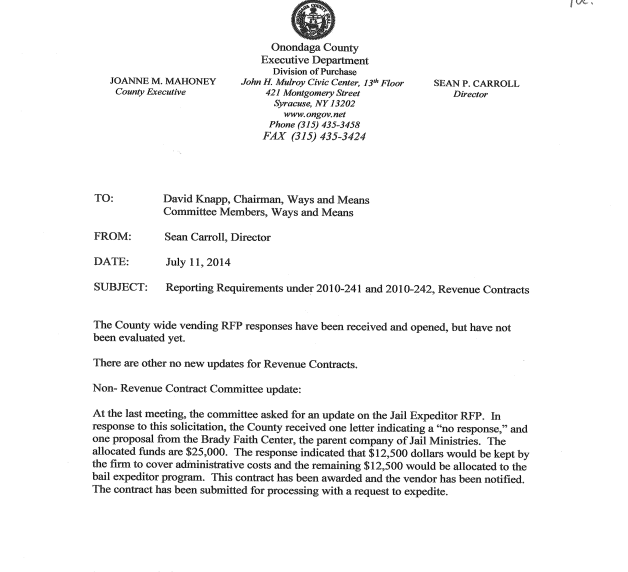
Chairman Knapp noted that the vending responses haven’t been evaluated yet; there are no new revenue contracts; Jail Expeditor was awarded to Jail Ministries.
The meeting was adjourned at 10:40 a.m.
Respectfully submitted,

DEBORAH L. MATURO, Clerk
Onondaga County Legislature
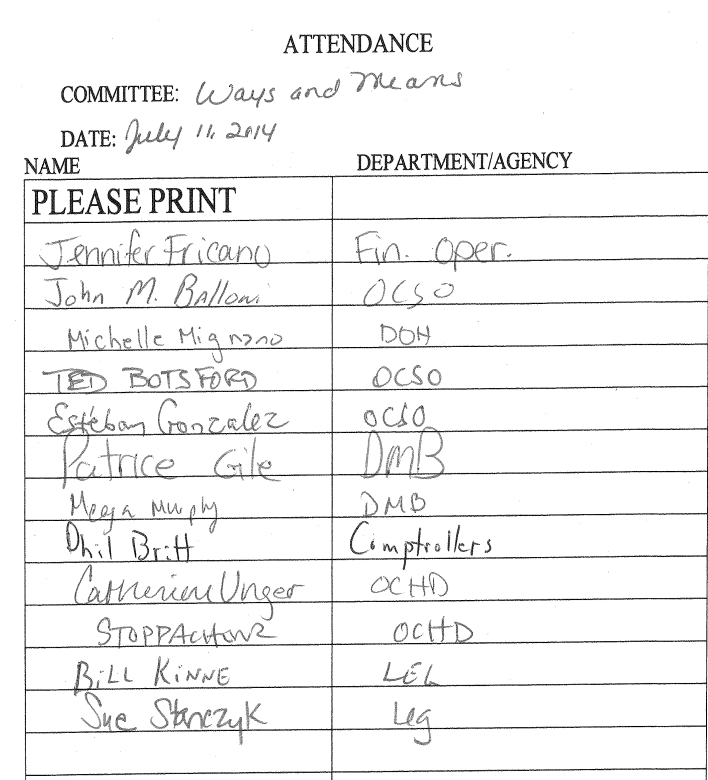
|































